#marvel comics review
Explore tagged Tumblr posts
Text
Fantastic Four (2022) #16 Review
Writer: Ryan North Artist: Francesco Mortarino Color Artist: Brian Reber Cover Artist: Alex Ross Publisher: Marvel Comics Reviewer: StoryBabbler The Baxter Building finally returned, and with it the return of the Fantastic Four’s children. After some time apart, the team’s family is truly reunited once more. But their kids are adventurous themselves, and just as soon as they come back, they’re…

View On WordPress
#fantastic four#Fantastic Four 16#Fantastic Four 16 Review#Marvel Comics#marvel comics review#marvel comics reviews
7 notes
·
View notes
Text
Uncanny X-Men #10 review

Well, ten issues in and we finally hear something substantive from Nightcrawler. The Outliers are still being attacked by the Wolfpack sentinels after Ground Bear and Jubilee bailed, the Graymalkin Podcaster clown show continues, and Moonbeam and Gambit go on a date mostly off panel. It looks pretty good but it's unfocused and shallow. The Outliers are the stars and the absence of Rogue/Gambit was refreshing. There's fart jokes?
Nightcrawler thinks to himself that he doesn't want to go back to being an X-Man, except he is an X-Man, isn't he? Realistically, he's having the same doubts everyone else has had. They were left unresolved and brushed aside so I'm not going to spend much time on this. Fool me thrice.
Anyway, he's painting a roof with Chelsea, who ends up being a mutant. Great, just what this book needs more of 🙄. She's probably the wisest person here who knows the mall is a bad idea. Kurt is really enjoying this place as a 'home' that's 'healing him.' How? Doesn't matter. He's just saying words and I wonder why he's even in the book. The lady whose kid he rescued rocks up with homemade German pastries for him which is a nice moment but it's not a substitute for character development. Things happen to him, mostly.
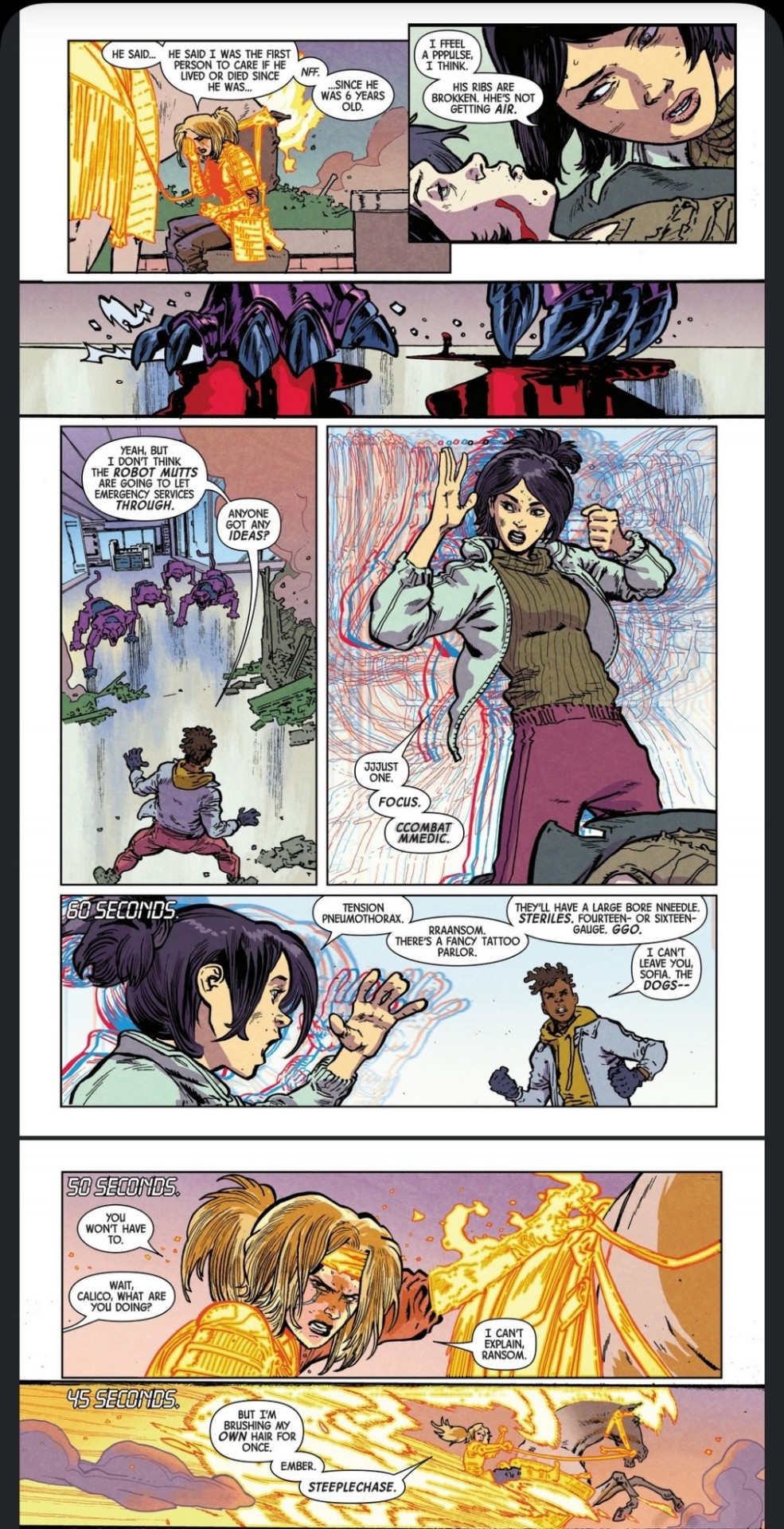
Meanwhile, Deathdream is bleeding out at the mall and The Outliers are rallying. The adult X-Men are feeling like a bit of a distraction tbh. The kids are being developed the most, learning, growing, making choices. It's great for them, but it's an awkward situation if you want more than the barest development of The X-Men. I look back on the first arc and how much time was spent flashing back to Xavier and Sarah Gaunt. No idea what degree of editorial meddling there is, but I find it hard to believe Gail Simone would intentionally take focus off the main characters to that degree.
Jitter uses her powers to become a master combat medic for sixty seconds and takes charge. For some reason the Wolfpack just aren't attacking them right now, despite having a taste for blood and no master.

Calico has her heroic moment and aims to distract the Wolfpack. Ransom is hunting for a needle to save Deathdream and stops to cheer her on despite the ticking clock. Said clock ticks down and he's just a little bit too late, so Jitter is relying on memory. Sure. The 'if X happens, run and leave me' moment is the 5th time this beat has been played this run, and it gets the same response each time. There's value in repetition but I'm not seeing any formalism or thematic purpose here, so it just feels repetitive. Don't get me wrong, the kids are the best part of the book, but I don't get these choices. It's the kind of thing even a parody of action cliché should be embarrassed doing - and it loses power each time.
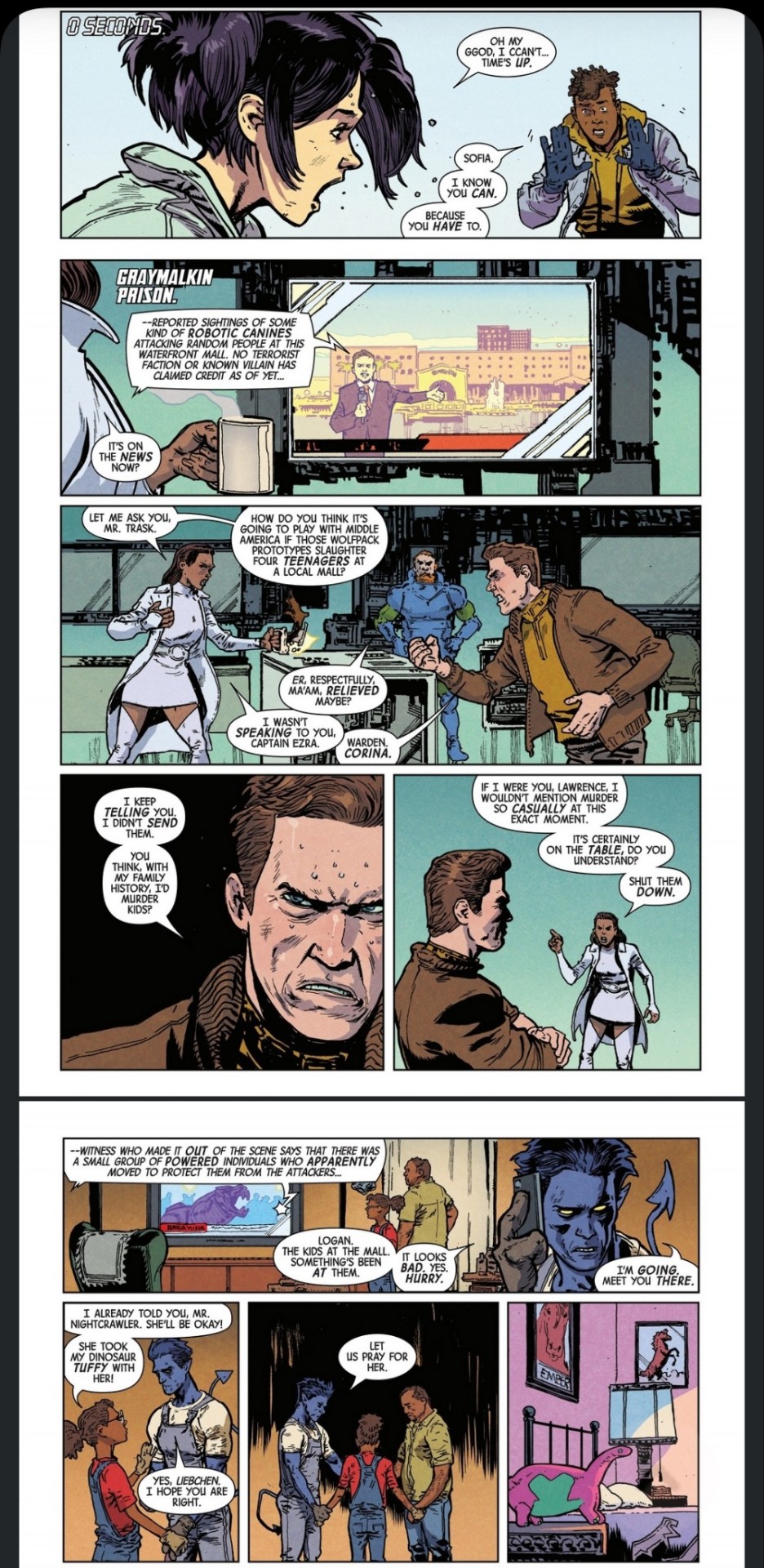
Time's up! We check in with Graymalkin, where the same dynamic as last time is escalating after the incident hits the news. Trask wouldn't kill kids because of his family history, apparently. Maybe he's referring to his sister, but that's a stretch. He had no problem with basically enslaving Juston Seyfert for his sentinel program. Whatever, maybe it's some new shit. The podcaster isn't happy, and keeps telling him to shut them down, something he's established he can't do. Not sure what was gained by including this.
Okay, Nightcrawler sees the Wolfpack situation on the news (TF are Logan and Jubilee?) He is obviously going to teleport there to meet them, but he stops for thoughts and prayers in a life or death scenario. DEEEEEP BREATH. Fucking really? Yeah, Kurt is Catholic, though he has spent the last few years having a major crisis of faith. He's also an experienced hero and pointedly not an idiot. Stopping to pray when kids you're responsible for are probably being torn to shreds is not something he would do, ever. It's embarrassing and frankly highlights why he shouldn't be in this book. Kurt Wagner is a complex, well-rounded individual. In this book he's been portrayed with 'is religious' as his defining character trait. I hate to go there but I'm dubious that Simone knows a damn thing about him - besides 'religious guy.' All that aside, if you only have room for a single flat character trait, take them out of the book. Kill him if you need to because this is painful. That would free up space for other characters to have beliefs, motivations etc.
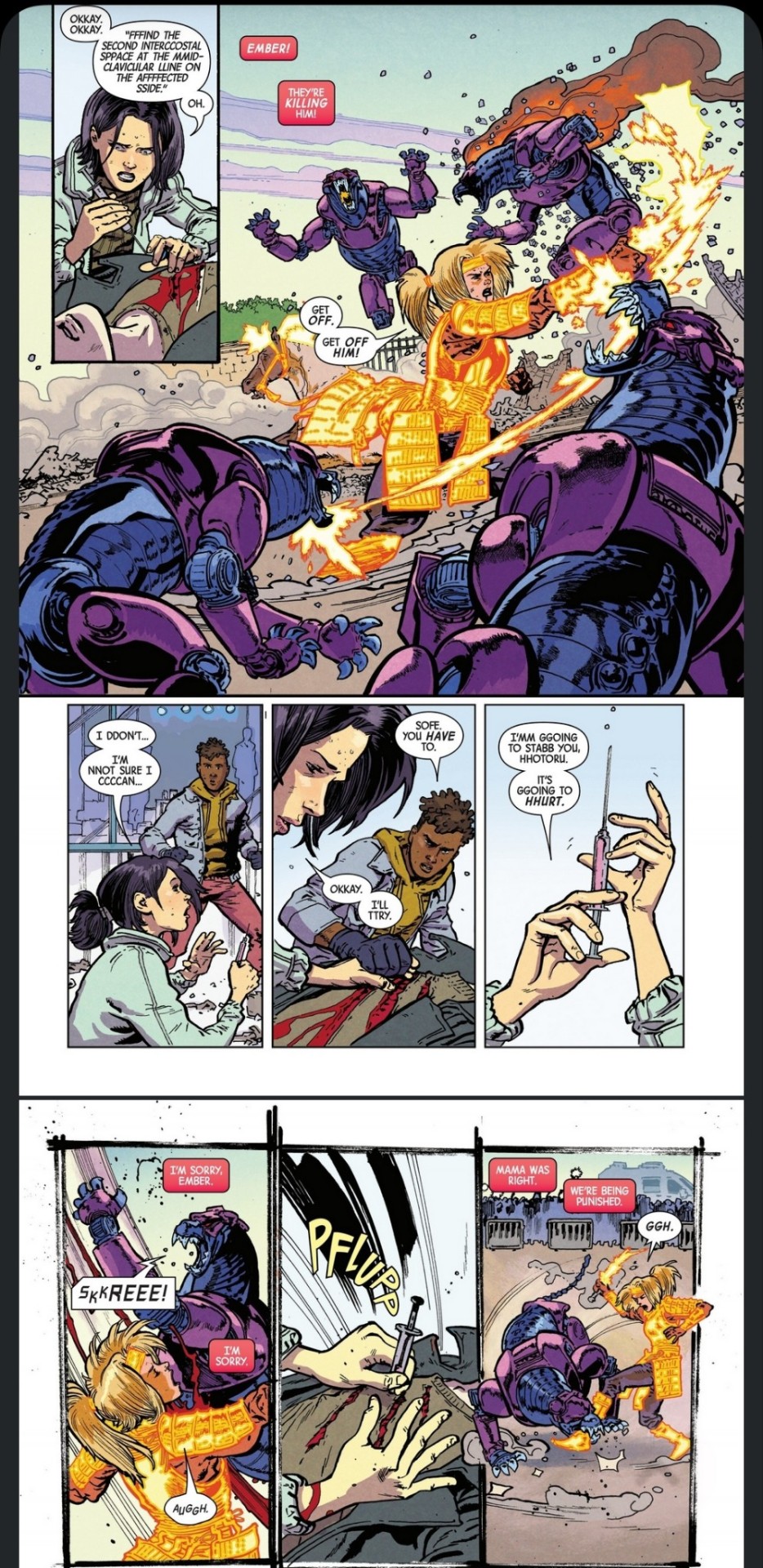
Jitter is going off memory and Calico is regulating. The memory is fading and Ember is down though. After encouragement from Ransom Jitter does the Pulp Fiction thing anyway - Calico lapses into despair, repeating her mother's abusive nonsense.

Nevermind, Ember is fine and so is Deathdream. More than fine even. Right as rain. Ransom is reinventing the fastball special except with Ember kicking him in the heart.
Logan and Jubilee finally show up to protect the kids they're responsible for. They're held up by a barricade and a cop. Okay this must be a shape shifter or something because I don't see Logan even asking for permission, let alone wasting time arguing with this bozo. He'd leap the barrier, or slice it. Famously he does not give a fuck and is very willing to use violence. If you thought that was bad, Jubilee convinces the cop and then wastes time flirting with him. Flirting with a cop while their charges are fighting sentinels. I guess now that she's abandoned her baby in Otherworld she's got time to date. This is unserious shit.

I wish I had the gall to follow up that waste of time with 'we're not gonna make it.' This run isn't going to make it. Kurt beats them there and has his second most substantial conversation of the run. With a killer robot dog. He teleports it into the sky and kicks it without hurting himself. Maybe Calico softened them up since last issue.
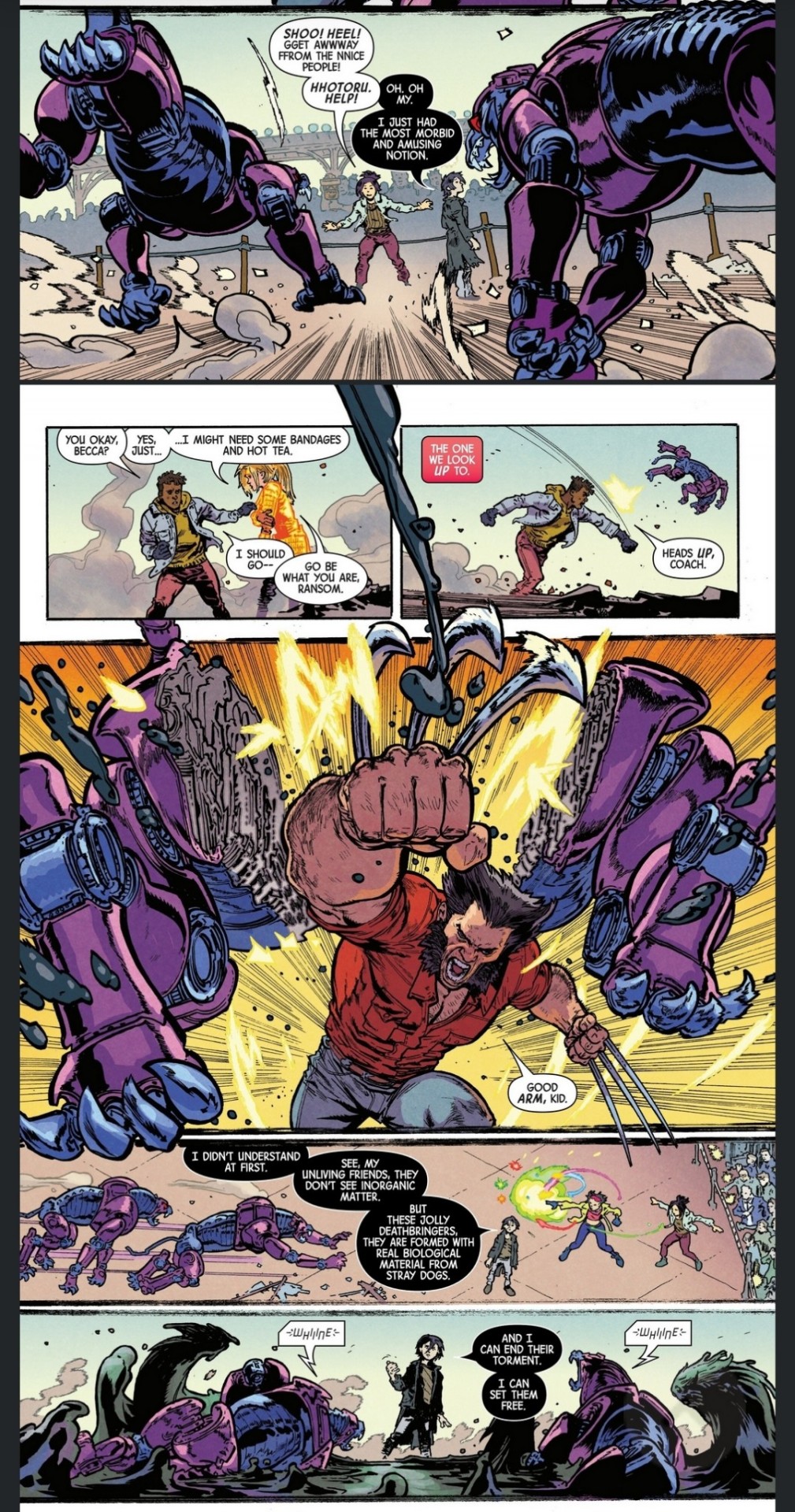
Jitter and Deathdream seem fucked with two Wolfpack sentinels racing towards them. Ransom and Calico check in, while informing us that Ransom is who they look up to. I mean, she's been doing all the fighting and Ransom was going to leave last issue but sure. Why not? He does throw a robot dog at Logan for him to slice, that's leader shit. If I was being generous I'd say it's a callback to Fall of the House of X #1, where Colossus did the same thing with an ORCHIS soldier. It doesn't matter because Deathdream suddenly figures out he can kill them all. Easily. It's loosely explained and I don't care enough to quibble. His powers are established and they apparently include a healing factor too.

With that, the threat is over. They got them all, together. Right. Logan compliments Ransom who asks not to be called 'kid.' I guess he's the man now, dawg. The mutants are hailed as heroes by local news and The Podcaster is not happy. They've finally tracked down the idiot responsible for this debacle, and she sends him to be tortured. The private sector is rough. I still don't know what the Podcaster's actual deal is, she's all over the place and I can't fathom why anyone obeys or fears her. What does she want aside from a mutant prison?
This book lacks consequences. The adults keep making huge mistakes that other people suffer for yet they get bailed out. It's narrative 101 - if your characters make a mistake they should have to deal with the fallout. They learn and grow. Rogue hasn't made a good decision yet and her team are complimenting her - directly after a prison break with no plan where she spent her time punching Scott. They sent the kids to school and Calico was kidnapped in an hour. Logan and Jubilee fucked up so badly here the kids nearly died. One actually did, but luckily it didn't stick. Kurt is praying and Jubilee is flirting while they're fighting for their lives. These actions aren't being used as mistakes to learn from, they're just things that happen. There's no tension because nothing really matters. No matter what they do things work out and they're hailed as heroes. Personally, I want more out of the flagship X-Men book.
When the wisest person in the book is 6 years old, it hangs a lampshade on how cartoonishly everyone is behaving. I'm thinking that's the point. The ragtag misfits have goofy adventures that seem like the end of the world at the time, but it's just Tuesday. It's the fun book where you don't have to think hard. Moonbeam, Ground Bear, and the Podcaster. PTSD, let's never talk about it again. Diction lessons, sugah. Let's pray.
A look at the letters page tells us everyone is loving the book, and they're definitely real people that aren't cherry picked. Good for them and good for you if you're enjoying it. I'm not loving it, but I'm not hating it. It exhausts me a little but I do enjoy reviewing it. Thanks for reading, Ground Bears.
#x men#x comics#uncanny x men#logan howlett#wolverine#nightcrawler#jubilee#the outliers#calico#jitter#deathdream#ransom#rogue#gambit#marvel#comics#reviews
112 notes
·
View notes
Text


1993's Marvel Year-In-Review Vol.1 #5 cover by artist Sam Kieth.
#Venom#Sabretooth#Deadpool#marvel#Sam Kieth#Sam Keith#marvel comics#Marvel Year-In-Review#super villians#art#supervillain#antiheroes#cool cover art#cool comic art#comics#1990s#90s#90's#1990's#victor creed#eddie brock#wade wilson#bring on the bad guys#comic art#comic books#Marvel Year In Review#marvel characters#so talented#comic covers#three amigos (or not)
114 notes
·
View notes
Text
Alright, since the events of Raid on Greymalkin directly affects Arkady, let's talk about it and how terribly the X-men have all been written in this narrative for this story to work and what it likely means for Arkady’s future.
So, in the first issue of Sentinels, Omega Red was captured and brought to Greymalkin Prison by the new Sentinels that Larry Trask and Warden Ellis have created to hunt down "bad" mutants. Keep in mind, Omega Red did absolutely nothing to deserve being thrown into a place like this, as his arc in the From the Ashes Infinity Comic shows. In fact, no one imprisoned here deserves to face what goes on behind these closed doors:

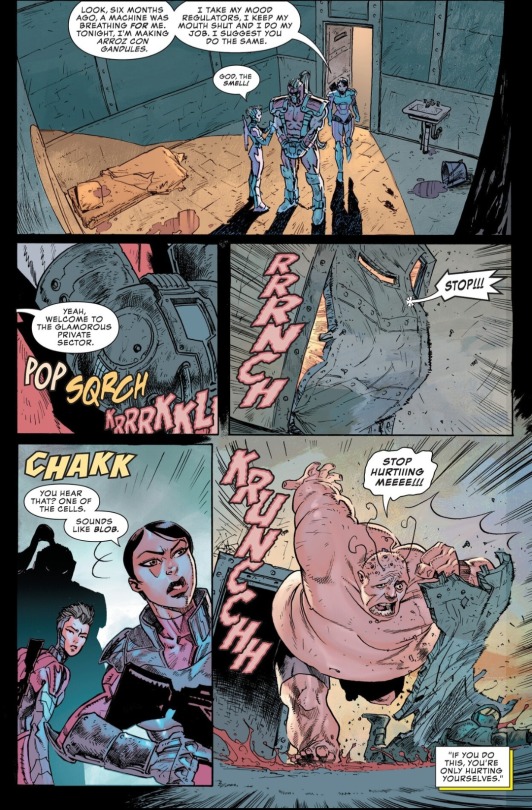
Here, we are shown the state of this prison. It's flithy, rat-ridden, and disgusting. These characters have to live in this place. Blob is being tortured, and -- as we later come to learn in the events of Raid -- brainwashed KGB-style through this method of torture to become a "trustee." I'm going to focus on this a bit as it is important to not only show how this is going to affect the imprisoned characters moving forward from this storyline, but also how it paints the X-men in a very bad light for allowing this to continue.
So, the characters who are imprisoned in Greymalkin currently are all characters who have been villains at one point or another. Every one of these characters has faced judgment and hatred for being what they are and what they were made into. Omega Red is a prime example of this. As a child, he feared and hated his powers:


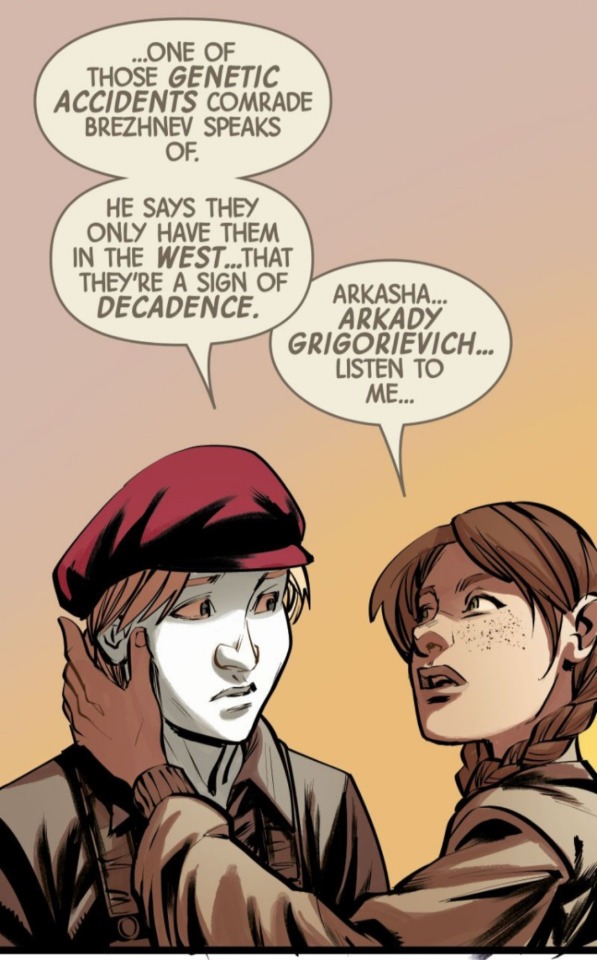
This is not a view of himself that has improved in adulthood. Arkady still views himself as a monster, that his abilities make him a bad person:

And this is a view he holds even after his time spent on Krakoa where he was able to start turning his life around. He doesn't have to kill to live anymore, and Sage had done a lot to help him improve himself while he lived there and worked as a member of X-Force. Even after all that and her encouragement, the doubt lingers. The self-loathing is still there. I know Arkady is not the only prisoner trapped in Greymalkin right now who struggles with such doubts. Who carries guilt like he does. It's a subconscious view that a lot of mutants have about themselves because society has pretty much told them for their entire lives that they're horrible people because of their powers. That they're all monsters and freaks of nature that need to be killed or locked up. And now, these characters have been put into a place where those fears and doubts about themselves and their place in the world are being indoctrinated into them to be the only thought they're allowed to have about themselves:

This creed that these trustees are forced to recite and believe in is just sickening. Any amount of self-worth that any of them started to get in their lives as of late is being stripped away again in the cruelest possible way. They're being told -- through torture mind you -- that they were born evil. That they're monsters. That they are lesser than humans and lesser than any other mutants because the genetic lottery gave them powers that were a burden and a curse rather than something that can easily be used to benefit others or that would allow them to pass as a normal human like so many of the X-men can.
Which brings this all around to the main point: the X-men. Before this new era even started, I want to point out a few things. The first is that the X-men worked with all of these current prisoners in one form or another while living on Krakoa. They (eventually) gave every one of these characters a chance. Blob was a bartender. Omega Red got cured of his need to kill and became a member of X-Force. Theresa was able to reconcile with Sean and Black Tom and bring their family together. The X-men were able to see these changes and progress made by all of these people. In Omega Red’s case, they even voted on the decision to give him a second chance, with Kurt being a voting member of the Quiet Council who decided to listen to Sage’s argument to have him brought back. They should know that these former villains have been making an effort to improve themelves. The last time they saw any of them, these former villains were all allies, which makes comments like this seem very out of character for someone like Kurt to make:
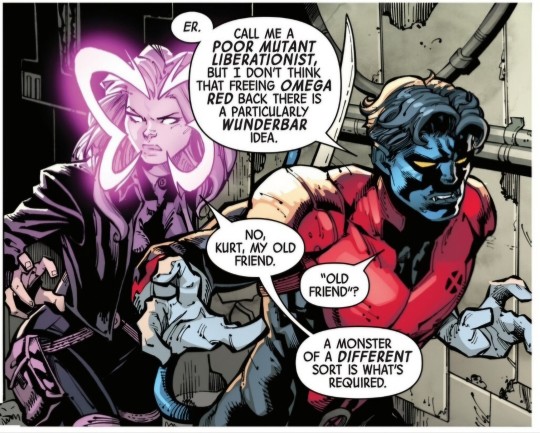
Kurt should know Arkady is an ally. But yet he's acting like Omega Red is a monster and that nothing he did on Krakoa to improve himself even mattered. Which, again, is something that all of these prisoners are being tortured into believing about themselves. Hearing the X-men hold the same view about you as these horrible guards do is not something that will make a person feel welcomed or loved or help them believe that they can be better than what the world made them into. The trust that Omega Red had started to build on Krakoa with the X-Men is going to start to crumble because of how they are continuing to view him and the plight that all these characters are in.
Which brings me to my next point: just what are the X-men doing? When Krakoa fell, Orchis had mutants under siege. They rounded up mutants in camps to strip them of their powers and torture them. The X-men and Avengers didn't stand for that and fought tooth and nail to get rid of Orchis. They went to war for their kind, for their right to exist. And they beat Orchis. But what did they really end up gaining at the end of it all? Well, if you're the X-men, you got some variation of peace or concessions, getting bases, time to relax and enjoy the world and your victory. Being able to pass for human really helps in that regard. If you weren’t able to pass, however?
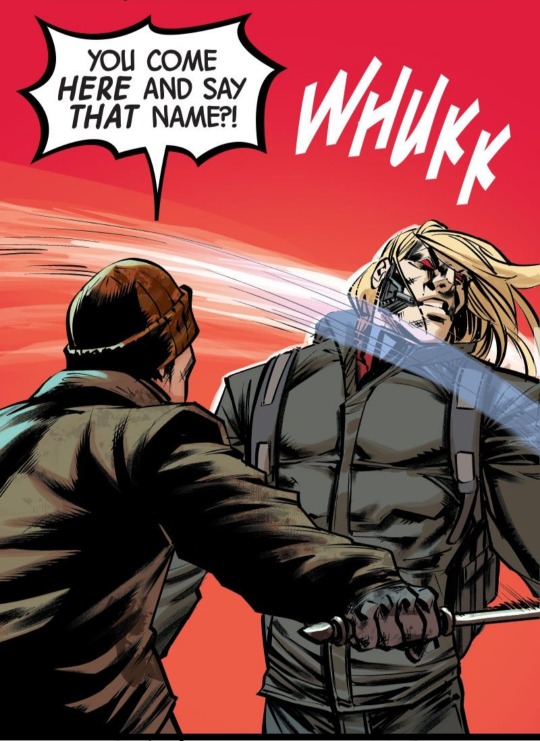
You faced violence. Discrimination. Hatred. Society is not kind to mutants who look different. Who are unable to blend in. These were the mutants --villain or not -- who benefited the most from Krakoa. Because they all finally had a place where they could be safe and accepted no matter their looks or abilities. When the X-men finally beat Orchis, they seemed content to leave everything at that and didn't try to reclaim any piece of what they had lost for the sake of those mutant brothers and sisters who were bound to struggle the most without a mutant community to support them.
They unfortunately seemed to just accept that everything was still fine since they themselves weren't personally being bothered by the hatred. But all the while, mutants have started to slip through the cracks without support from the wider mutant community. A community that the X-men are supposed to protect. And this extends beyond characters like Omega Red and the other Greymalkin prisoners, although they are the ones currently being tortured the most. Lifeguard. Chamber. Firestar. These are all characters that have faced a world that hates and fears them without the X-men doing anything to help them. Why haven't the X-men done anything? Because so many of them just gave up and settled for what they have. They had the luxury to be able to do so because they look human. Their powers aren't horrendous abilities that they can't control or that kill people.
Even still, even if they want to take a break, they should all know the fight is not done. They are all well aware of what was done to their former home, the X-Mansion. They know it was turned into a prison. Jubilee scouted it out. Rogue and Scott had phone calls about it. And yet they did nothing. They let it continue to stand, this place which sullies the name of the X-men and their history. This place -- which treats mutants in a similar way to how Orchis treated mutants -- is allowed to continue to grow and thrive even after the X-men and Avengers had just put their foot down and said such places were not going to be tolerated. Now they're tolerating it? Why? There is absolutely no reason to wait. And yet they did. They did absolutely nothing to correct this injustice towards their fellow mutants until one of their own was impacted. Until they themselves finally started to face the same things characters like Omega Red had already been facing for months now. It was only when they were personally threatened that they decided to do anything. Which brings us to the Raid itself.
The Raid... was a mess. A disaster. A series of unfortunate events that didn't have to be. Instead of going into this place, seeing the atrocities committed on the grounds of their first home and feeling a strong urge to eliminate this threat, what did they do? They fought amongst themselves. They argued. They did absolutely nothing to help any of the prisoners. Kurt left Omega Red to rot in his cell. They did nothing to free the trustees nor made any sort of real threats of anger towards the warden for what she was doing to their fellow mutants. Rogue came the closest to saying this place was wrong, but all her concern was devoted to Charles Xavier, the only mutant willingly imprisoned in this place. No concern was given to any of the others at all until it was too late.

And yet, again, this whole thing just seems wrong and runs as an antithesis to what the X-men are, what they stand for, and what they would actually tolerate. A big laser gun should be something they should be able to take care of. The X-men shouldn't be this easily cowed into obedience after everything they recently faced with the fall of Krakoa and how they fought back against Orchis. Thry shouldn't be taking "no" for an answer. They shouldn't allow for this prison to stand. They NEVER should have. And yet, time and time again here, they have failed in their work to actually help their kind, to make the world a better place for mutants. This is not the X-men I fell in love with reading about. This is not the X-men that I know. The X-men should be doing so much better than this. But they're not. They've rolled over and accepted that this is the reality and that they are powerless against a podcaster and her satellite weapon.
This is something the X-men should have never allowed to happen. They should have never allowed things to get this far. And as a result, by doing nothing when they could and SHOULD have been doing something, their enemies were allowed to regroup and begin targeting the most vulnerable members of the mutant community. The X-men failed in their responsibilities and let a place full of cruel and unusual punishment to stand because they weren't the mutants being personally affected by what was happening. And now, so many more have to pay the price for their inaction.
Where does that leave the unfortunate prisoners of this place? At this point, beyond being torn down in mind and body, it's hard to say. Every single one of them does have the right to call the X-men out on their failure, though. They all would be very justified in their anger at being left behind, both after Krakoa fell and here at this prison. In Omega Red’s case, I could very easily see this whole experience souring him on the X-men again and making him very unwilling to trust them again. Because even after everything that these former villains have been trying to do, there's still some part of the X-men that seem to view these unfortunate souls as monsters that deserve to be treated like animals. That they deserve to get beaten, fed rotten food and forced to sleep in wretched cells.
The X-men have failed in their role to protect mutants. They have failed to stand for what is right and failed to help their fellow mutants from being condemned to one of the worst fates a mutant can face: to be weaponized and used like a tool to attack other mutants. The Raid on Greymalkin story arc is a blight on X-men comics and is an example of what not to do when doing a story like this. Characters and their histories cannot be ignored. Petty fights over arbitrary issues should not be taking place when there are SO many higher priorities that need to be taken care of. This story was nothing but disappointing and sours me on the direction Marvel is taking the X-men. There is nothing to look forward to. Like the mutant prisoners who were left behind to be further tortured and devalued, we the readers have been left to a similar fate, wondering when in the world we will finally be freed from this prison that Marvel's writers are putting us in and what we -- and the characters we love -- will even come out on the other side looking like.
#omega red#arkady rossovich#marvel comics#x men comics#xspoilers#uncanny xmen#notmyxmen#blob#theresa cassidy#raid on graymalkin#comic review#the xmen should really be doing better than this#i am immensely disappointed in them and with marvel for this storyline
106 notes
·
View notes
Text

I don’t usually draw guys (i’m just a girl) but i watched Deadpool and Wolverine and i got inspired!
#im going to draw more of him soon#other’s art#the little creature in purple pen next to him was a doodle that my niece did!!#and then i imitated her too!!!#deadpool#deadpool and wolverine#deadpool fanart#marvel#marvel fanart#dp#deadpool comics#deadpool and wolverine movie#movie review
357 notes
·
View notes
Text

LOVEDDDD Magik #1!! In just a few pages Ashley Allen managed to fix most things wrong with Illyana's characterisation over the last decade 😭
-She's reflective and sometimes too in her head again
-She's using ACTUAL MAGIC!!! WE ALL CHEERED!!

-She's protecting people instead of just wreacking villains
-Her dry humour is top notch
-And a personal vendetta I had, her soulsword is magic again!!! Not just a sword, but a sword that disrupts supernatural things 😭

The gore was also pretty surprisingly gnarly! And I'm actually screaming at the fact that she healed herself with magic. How can anyone stop her now...?!!?!?!

The fight was very engaging to me with the villain having a very unique power set!
Very very very good start! Everything about yana's behaviour and the commentary made shows us that we're in good hands even though I already knew that from the Magik Blood hunt one shot by Allen!
Though I wish we didn't have the Alaskan setting and a lost limbo, we're still in for a great ride!
Pick up your Magik guys!! 🗡️⚔️ ✨ 🔮
#magik#illyana rasputin#marvel#xmen#new mutants#marvel rivals#x men comics#comics#review#Magik (2025)
102 notes
·
View notes
Text
Comic Book Review: Runaways by Rainbow Rowell
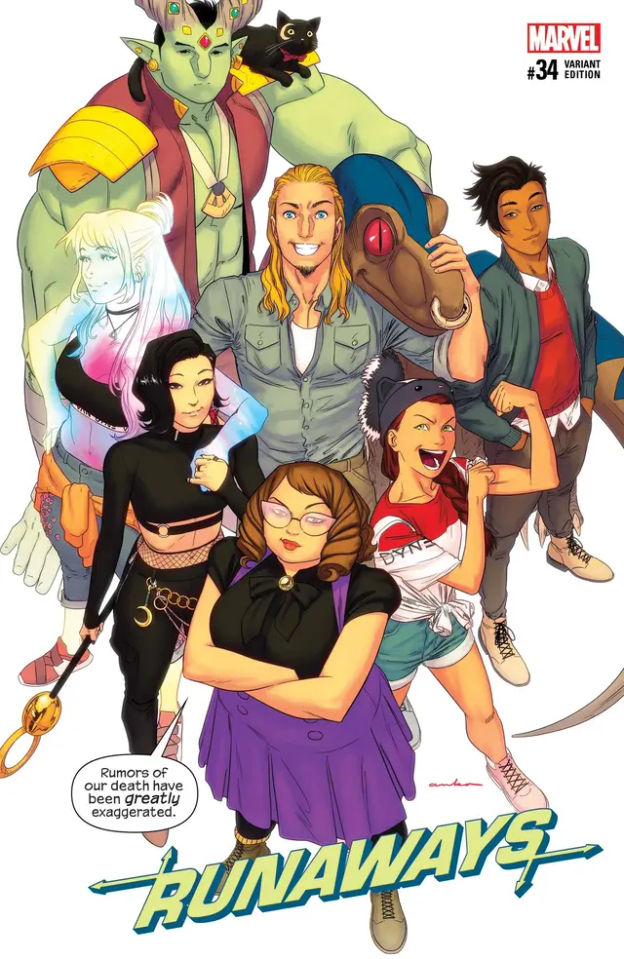
Hello, all. Today I will be taking some time to discuss a comic book I enjoy. This is the first in what will hopefully become a series of long-form comic book reviews I'll be writing for this blog as I continue working through my backlog of unread comics as well as ones I'm rereading, both on my own and through me and @bimboficationblues' book club.
I first read the original run of Runaways in digest trade paperback format at my local library when I was in middle school, and the book hit me at the exact right time, since I was pretty firmly the book's target demographic - young, restless, and beginning to grow resentful of the adult authorities in my life. I never read the 2017 revival, as I was not reading comics when I was in high school and college, but I was at my local library - a different one, I don't live in Texas anymore - while waiting for the power in my apartment to come back on due to an outage, and discovered that they carried the full series in trade paperback. I decided to check it out and see how it held up to the original run, and found myself pleasantly surprised by how much I liked it - enough, clearly, to make this post. I'll get into more detail about the 2017 book later in this post, but I'd like to first give an overview of the original series to provide some context for how this book came to be, since it's quite a niche, cult-classic book as far as Marvel titles go.
Part One: Born to Run
At the turn of the century, comic books faced a number of problems. The bottom had fallen out of the industry in the early 1990s due to the burst of the speculator bubble, sending shockwaves that continued to reverberate into the early 2000s. Marvel Comics had nearly been bankrupted and stripped for parts, surviving only by the skin of its teeth, and was only just getting back on its feet. But now, another threat was looming: anime and manga. Imported comics from Japan were beginning to capture a larger and larger market share of comics sold in the United States, fueled by the popularity of Dragon Ball, Sailor Moon, and others on television. Marvel sought to fight back by producing books which would appeal to young fans of these Japanese imports and act as gateway drugs into more standard Marvel fare. Their first effort came in 2000 with the utterly embarrassing Marvel Mangaverse, a group of books which copied superficial and stereotypical aesthetics of manga, without any of the substance.
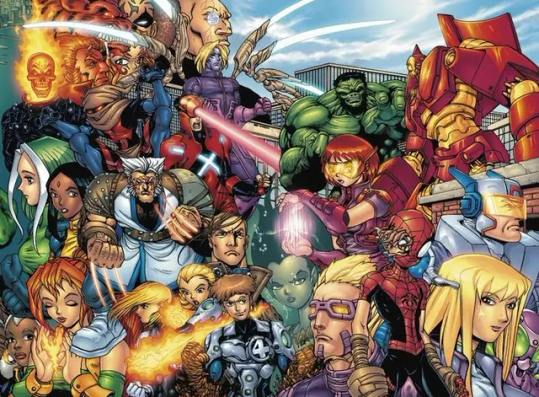
Just look at this shit, man. Anyway, in 2003, Marvel tried a different approach with their Tsunami imprint. The books in this imprint would also employ art styles that reflected the influence of anime and manga, but would feature character-driven, in-continuity storylines aimed at a variety of age ranges. Among the titles Tsunami would publish was a book written by Brian K. Vaughn (known at the time mainly for his work at DC's Vertigo imprint, including a run on Swamp Thing and his own Y: The Last Man) and illustrated by Adrian Alphona (who would go on to co-develop Kamala Khan with G. Willow Wilson) titled Runaways.
The initial premise of Runaways was really quite brilliant in its simplicity: Alex Wilder, Nico Minoru, Chase Stein, Gertrude Yorkes, Molly Hayes, and Karolina Dean are casual friends bound together mainly because their parents are all friends - actors, engineers, lawyers, and influential people in the Los Angeles area - who gather once a year for a charity event.
As the kids are left bored and alone while their parents meet at Alex's house in Malibu, they find a secret passage and are able to observe their parents at the meeting, learning that, in truth, their parents are a group of supervillains known as the Pride, who control crime and vice in Los Angeles, and who conduct human sacrifices in arcane rituals.
As the kids attempt to discover more about their parents in order to find evidence to bring to the police, they each begin to discover unique powers and abilities: Gertrude has a psychic link with a genetically-engineered deinonychus, Karolina is a light-powered alien with the ability to fly, Molly is a super-strong, super-tough mutant, Chase gains access to powerful technology created by his parents, and Nico is able to summon a magical focus known as the Staff of One when she bleeds, which she can use to cast powerful magical spells, with the catch that she can never cast the same spell twice. Alex, with a genius strategic mind, becomes the group's leader, and with the group learning that the police in LA belong to the Pride, they run away from home and drop off the grid in order to find a way to put a stop to them.

The first volume of Runaways chronicles the kids' conflict with their parents, as well as run-ins with a vampire named Topher and Marvel's original runaway teen superheroes, Cloak and Dagger. Eventually, they learn that their parents were gathered to serve godlike giants called the Gibborim and conduct a ritual which would wipe out all life on Earth, save for six of the Pride - or more specifically, their heirs, the children. The volume ends with the team's climactic confrontation with their parents, as they begin the ritual to end the world, with Alex revealing himself to be a mole in the group and having secretly been on the side of the Pride all along. After Molly disrupts the ritual, the Gibborim arrive and vaporize Alex and kill the Pride, with the kids barely managing to escape. In the aftermath, the kids are placed into foster care, which they promptly run away from, becoming teenage fugitives once again.
The first volume of Runaways lasted only 18 issues, but sales of the digest format trade paperbacks (another thing copied from how manga is distributed in the US) proved so strong that a second volume began publication in 2005, featuring the same creative team. This volume saw the kids continue to evade the police, adult superheroes, and social services. Along the way, they recruit a few new runaways, including Victor Mancha, a cyborg built by the Avengers villain Ultron, and Xavin, a shapeshifting, genderfluid Skrull who imposes themself upon the group as Karolina's fiancee due to a marriage arranged by her parents. They also take a trip to New York City to help clear Cloak's name when he's accused of attempting to murder Dagger. There, they come into conflict with the Avengers, and get sushi with Spider-Man.

Over the course of the second volume, Gertrude is killed in a fight with a reformed Pride made up of a time-displaced version of Alex's father and his MMO friends, and Vaughn's run on the title ends with a story in which Chase, who is grief-stricken after her death, makes a deal with the Gibborim in order to bring her back in exchange for a sacrifice. The deal falls through, and the kids are forced to fight the gods that their parents once served, ultimately managing to defeat and erase the Gibborim from existence.
After Vaughn left the book, unfortunately, Runaways started a long period of decline. He was replaced as writer on the book by Joss Whedon, who penned a couple middling stories, including one where the kids fight the Punisher and the Kingpin, and another where they're flung back in time to 1907 New York, where they recruit the final member of the team, a young mutant and child bride named Klara Prast who can make the flowers grow. Yawn. Volume 2 of Runaways ended with issue 30, and the book was relaunched with a new #1 in 2008, this time with the creative team of Terry Moore (best known for his indie book Strangers in Paradise) and Humberto Ramos (a veritable workhorse whose portfolio speaks for itself, particularly his work on Spider-Man). This brief, forgettable run was followed by a fill-in issue or two by Christopher Yost, and then a final, mediocre arc by Kathryn Immonen which ended the series abruptly on a cliffhanger.
After this, the wilderness years. Characters from Runaways appeared with some regularity - Nico, Chase, and Victor all played major roles in various Avengers spinoff books, none of which suited them particularly well - although in the pages of Avengers AI, Victor would forge a friendship with a reprogrammed Doombot which would play a role later. Mostly, though, it became clear over the years that these characters did not work in normal superhero books, because they were not normal superheroes - they were Runaways. Part of the problem the book had come to face in the later years was a failure to understand that point. The Vaughn run had proven the potential of the characters and concept of the Runaways - they needed a writer who understood that potential, and how to bring it out - and they could have a renaissance.
Then, in 2017, a Runaways TV show premiered on Hulu, to tie into the Marvel Cinematic Universe, and Marvel, for the most cynical and synergistic of reasons, decided to give them that renaissance.
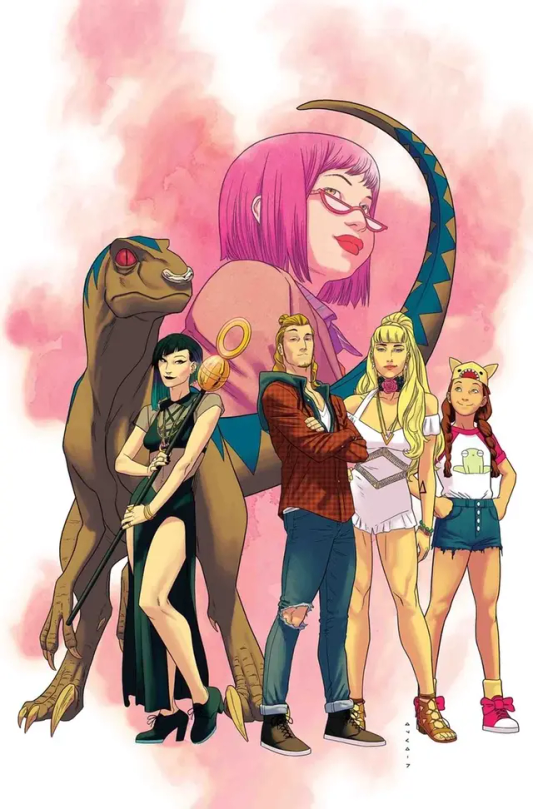
Part Two: It's Only Teenage Wasteland
Runaways volume 5 (volume 4 was an unrelated Secret Wars tie-in) is written throughought by Rainbow Rowell. Rowell's background is in contemporary young adult fiction, which isn't usually my cup of tea, but translates very well to this comic. Runaways, at its core, is not a superhero book- a point which will be made more explicitly later in the series - it is a teen drama with superpowers. Angst, sexual tension, and resentment of authority are all key elements of the series, which Rowell employs effectively throughout. Joining her on art for the initial run of the volume is Kris Anka, who would later go on to be the lead character designer for Spider-Man: Across the Spider-Verse. Anka's art is colorful and expressive and complements the tone of the series brilliantly. It's probably the best Runaways has ever looked. Of particular note are the outfits Anka designs for the characters, which change from issue to issue and help to characterize each Runaway visually.
The book picks up with the Runaways having split up, with Molly living with her grandmother, Victor having been reduced to an inert, deactivated head following his apparent death in Avengers AI, Karolina in college and dating Julie Power of Power Pack, Klara in foster care, Xavin in space, and Nico in a shitty LA apartment after a brief stint with the all-female A-Force. The inciting incident of the book occurs when Chase appears with a time machine, having recovered the dying Gert from the events of volume 2. Nico is able to use her magic to save Gert's life, and she wastes little time pushing to get the rest of the gang back together.
Of course, two years have passed since Gert died in-universe. Karolina, Nico, and Chase are all adults now, and Molly is a teenager now, happily living with her grandmother. Things changed while Gert was away, and there's no way to go back to the way things used to be.

The first arc of the book establishes some core themes which will continue to be relevant for the rest of its run: change, growing up, and family bonds. Gert is the heart of the book, despite her vociferous denials of that being her role. She is the driving force behind reuniting the Runaways, and her character is explored in this book more than it ever was in the Vaughn run - her negative self-image, which she hides behind an acid tongue, is a recurring focus. Of note is a scene where she discovers that her purple hair, which had previously set her apart and helped her to feel as if there was something special about her, has become a common fashion statement in the time she spent being dead. Her relationship with Chase is also examined - the age gap that now exists between them precludes any resumption of dating, and she eventually gets together with Victor - but Chase still loves her despite himself, and holds out hope that things can change when Gert gets older and the age gap is less of an issue. It's a little creepy, but psychologically understandable, as is his giving into temptation when a future version of Gert appears and practically throws herself at him.
Rowell's focus on character is central to what makes the book work. There are few titanic threats and fewer supervillains; the drama in Rowell's Runaways is driven by the characters and their relationships to one another, which are given a fresh perspective due to the characters having aged and grown since the previous volume of the series. Molly struggles with the idea of growing up and having to face adult fears and responsibilities, especially when her best friend in middle school offers her a way to stay young forever. Nico struggles with the feelings she's realized for Karolina - picking back up a plot thread from Xavin's introductory arc - as Karolina struggles balancing university, supporting the Runaways, and being a good girlfriend, failing at the latter as Julie breaks up with her - but in the process allowing her and Nico to finally have the right timing.

Also complicating matters are Victor's Doombot friend, who becomes a recurring character and joins the main cast in the back half of the series, and Alex Wilder, who has returned as a living corpse, with the children of the Gibborim on his heels. Rowell's portrayal of Alex is one of the series' most interesting aspects, as a young man burdened by his past mistakes and whose inability to acknowledge or account for them prevents any reconciliation with his one-time friends, and leads him to continue making the same mistakes over again. The only bond with the group he is able to maintain is with Molly, the only other Runaway who still misses her parents, and they have some very sweet interactions in a spotlight issue which serves as a look at what things could be like if Alex was willing to own up and atone for how he's hurt the others. His arc is left unresolved, though, for reasons we'll get more into in a bit. Doombot, meanwhile, has a brief storyline in which he comes to grips with his sense of individuality separate from the programming he was given by Doctor Doom, but other than that his primary role in the series is to serve as a caretaker, of sorts, to the kids, as well as a source of consistent comic relief.
That's another thing about this series: it's very funny! Much of the humor is character- and interaction-based, which is very much my style of humor in comics, but there's also some really nice sight gags and creative use of lettering and sound effects to create jokes. A lot of the humor in the original series can be hit-or-miss, in particular a lot of the more dated references, so the humor in this volume is a refreshing change of pace.
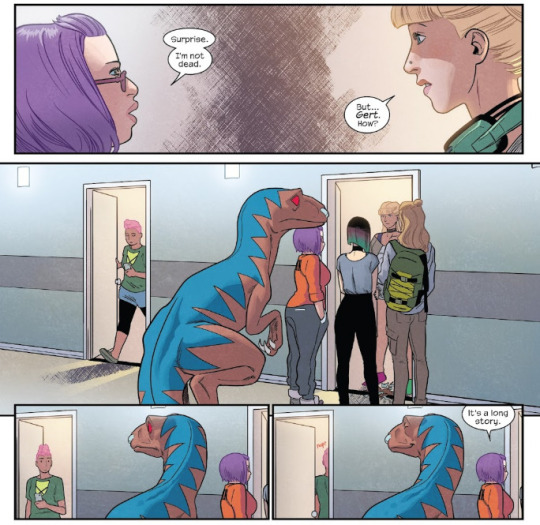
Following the fight with the children of the Gibborim - one of whom, Gib, sides with the group and becomes their newest member - the series enters its midpoint, in which Karolina drops out of college and begins moonlighting as a superhero as an unhealthy outlet for her anxiety, which ultimately ends up dragging the other Runaways into the orbit of Doc Justice, one of Los Angeles' premier superheroes, who outfits and equips the group as his new J-Team. I'm conflicted on this arc for a few reasons. The first is that it interrupts what I felt was an interesting arc for Karolina using superheroics as a coping mechanism, which I felt wasn't explored fully before Doc Justice showed up. On the other hand, though, the arc really gives Gert the spotlight after some time of having it off of her, and she's really able to shine as the one Runaway excluded by Doc Justice due to her weight and lack of powers, both key elements of her own negative self-image which haven't gotten a lot of focus since the early arcs of the series. Further, the arc serves to drive home the point that the Runaways are not superheroes and that Runaways is not a superhero book in the traditional sense. Seeing everyone in spandex and responding to distress calls just feels wrong. And Doc Justice is a great villain for the series: a conceited superhero obsessed with fame and media attention, who has systematically arranged the deaths of various teammates over the years in order to maximize sympathy and publicity. It's all very Hollywood. The ultimate downside of the Doc Justice arc, I think, is that after it's done, the series only has seven issues left. The eternal curse of Runaways, to have each volume cut too short, rears its head once again, and in using one of its final arcs to make a meta-commentary on the series as a whole, it sacrifices some opportunities for the character interactions and interpersonal drama that really make the book shine.
The final arc makes an effort to pivot back to that interpersonal drama, including a delightfully fucked-up romance between Chase and a future version of Gert who has traveled back in time to supposedly save him from himself, which blows up as you might it imagine it would once present Gert and Victor stumble across them. There's also a plot thread of Molly, Chase, and Nico helping a visiting Wolverine and Pixie track down a mutant who sent a distress message, in which Nico very nearly kisses Pixie due to her established character flaw of getting caught up in the moment, and it seems like she and Karolina are going to have an honest conversation about it - only for the conversation to instead be about the frankly much less interesting conflict Nico has been facing about the evil sorcerer whose spirit is housed in the Staff of One, and who is taking a piece of her soul every time she casts a spell. It's a conflict that could be interesting if more focus was placed upon it, but it's the subject of one issue prior to this and the end of the series means that it ends up going nowhere beyond Nico entrusting Karolina with the staff in the end. That's a major flaw in this run, though one that isn't entirely its own fault - its abrupt end means plot threads, like future Gert's abduction of Chase, Nico's conflict with the spirit of the Staff of One, and Alex's usurpation of the Doc Justice mantle, are left hanging.

It really is unfortunate, and makes the time spent on the Doc Justice arc, which probably could have taken four issues instead of a frankly indulgent seven, feel even more egregious and unnecessary with hindsight. This series has a leisurely pace, which is good when it allows character interactions and dynamics to stretch out and have maximum impact, but it also means that at the end, when everything has to wrap up relatively quickly due to the amount of time taken in previous arcs, there's a disorienting and frantic energy, like trying to get your room cleaned five minutes before your parents get home. In particular, the last issue crams a ton of stuff in, to an exhausting degree - Karolina summons her people to take her into space and treat her for injuries she sustained in Doc Justice's efforts to martyr her, future Gert enacts her plan to kidnap Chase into the timestream, Gert's time traveling parents show up for some reason, Alex is surveilling the team for reasons unknown, Xavin is now a general of Karolina's people... it's a lot to leave on a cliffhanger.
Rowell's Runaways is a good book, and I do recommend it, either on its own or, preferably, after reading the original 2000s run. It does a great job of moving the characters forward, maturing them, and giving them more adult problems to deal with, while maintaining the series' core themes of identity, questioning authority, and anxiety towards adulthood. It simply doesn't have enough issues left at the end to resolve all of its plot threads, and that is what ultimately holds it back from being great. 38 issues is a good run, better than any volume of Runaways before it was able to achieve, but its pacing choices and the number of plates it attempts to keep in the air leave the reader wanting more.
But, to its credit, it succeeds in making me really care about what that "more" could be.

Part Three: Run Away With Me
Volume 5 of Runaways ended with issue 38, cover date October 2021. It outlasted the TV show it was meant to tie in with by two years - a TV show that was eventually pulled from streaming as a cost-cutting measure. In the years since the series concluded, not much has been happening in that corner of the Marvel Universe. The characters have made few, if any, appearances, and there's been no talk of a sixth volume, despite the plot threads left hanging.
Well, that sucks, you know? Runaways is such a unique series with such a special voice and perspective in superhero comics, and it deserves a place in Marvel's publication roster as much as the millionth Spider-Man or X-Men spinoff does. It has never sold spectacularly, but it has an audience and, crucially, has always been good for its originally intended purpose: giving Marvel a backdoor into the teen and young adult market that has for decades now largely eschewed comic books. Manga sales now account for nearly half of all comics sold in the United States, and while Marvel now mainly serves as an IP farm for adaptation into the much more lucrative MCU, I think there's value in a series like Runaways that's able to tap into that YA market in a way Marvel's other books aren't able to.
I think with the right creative team, Runaways could easily become a solid seller that is able to have a respectable run of issues. Volume 3, as well as the original Vaughn run, prove that this is possible. I would seek out a writer like Mark Waid, whose bread and butter is character work and who was able to revitalize Archie's comic line to appeal to YA readers, or Ryan North, whose Fantastic Four is one of Marvel's best titles right now primarily on the strength of its character dynamics, or David Willis of Dumbing of Age, whose work for the past decade has entirely centered on young adults finding themselves, to take over the reins of a revival, someone with established chops in the genre. Pair them with a quality artist - think Chris Samnee or Todd Nauck, and I think there's a recipe there for a hit.
I hope we see Runaways come back again, sooner rather than later. Another eight year hiatus would be unbearable.
G-d help me, I wanna see these crazy kids again, and see where the road takes them.
FINAL SCORE: 3.5/5. A good comic.
142 notes
·
View notes
Text










The reviews are in for Sex Lives of Superheroes and they're just swell!
If you would like your own copy of this fun, cool book for awesome people you can find all the purchase links right here.
#Thanks to all who have reviewed!#Sex Lives of Superheroes#Marvel#DC#Comics#TFSH#Texts From Superheroes
85 notes
·
View notes
Text
YOU GUYSSSS THE MOVIE WAS SO GOOD



#୨ৎֶָ֢nat yaps(abt cinema)#marvel#mcu#marvel cinematic universe#marvel comics#aaron taylor johnson#atj#kraven the hunter#sergei kravinoff#russel crowe#Calypso ily#ariana debose#fred was so pookie he just LOVES playing pathetic men🥰🥰#fred hechinger#rotten tomatoes/IMDb idc about y'all's goofy ahh reviews🤣🤣🤣🙏🏻#like hunt ME🤤🤤#my pics
68 notes
·
View notes
Note
🔥Punisher: Last Gun on Earth?
This ask is referring to the fairly-obscure 2010 zombie apocalypse Elseworld Marvel Universe Vs The Punisher by Jonathan Maberry, as well as the two prequels following Wolverine and Hawkeye at different points in the same timeline. I've been meaning to do a more comprehensive write-up on this for quite some time, as it was a series distinct from but very visibly in conversation with Marvel Zombies, which Maberry was also peripherally involved with. The elevator pitch is that a fuckup by the Punisher during a hit on the Russian Mob results in a cold war bioweapon getting into the biosphere, eventually turning almost the entire human population, and most of the superheroes, into adrenaline-fueled 28-days-later style rage zombies. Content Warning under the cut for discussions of racism


Despite its many, many flaws, there was a lot I enjoyed about this series, and alongside Marvel Zombies it had a not-insubstantial impact on my own aesthetic sensibilities, which I think probably comes through in a lot of my zombie artwork. The first mini, Marvel Universe Vs The Punisher, is a pastiche of I am Legend, with Frank Castle in the role of Robert Neville, an infected Deadpool in the role of Neville's abnormally sentient neighbor Ben Cortman, and with a zombified Spider-Man the white whale that he's spent five years hunting through the remains of Manhattan. Before I get into the rancid shit, I'm going to talk about what I enjoyed:
While the series succumbs to all-too-common Punisher Wank in terms of his efficacy in taking down a number of the A-list infected heroes, it ultimately comes out the other side as a pretty competent piece of character work for Frank; the series is grimly aware that a virus turning most of the human population into a shooting gallery of sadistic cannibal maniacs would be something like Valhalla for Frank, regardless of his pretensions to the contrary. Moreover, it's subtly implied that Frank's belief that he's immune is incorrect, and what's actually happening is that a virus that turns you into a vindictive, dogmatic maniac with a hardwired us-or-them mindset had no effect on him because he was already like that. There are ultimately revealed to be thousands of other survivors in New York, all of whom have spent five years studiously avoiding him because they think he's batshit insane. Even zombie Spider-Man, played up as the Biggest Bad, is ultimately revealed to have retained enough humanity to protect his uninfected family the entire time, whereas Frank is ultimately painted as unrelenting genocide machine whose psychological inability to give quarter ultimately makes him worse than the infected.
From there the series extrapolated some hilarious commentary on the genre as a whole; the zombie outbreak was going on for months before reaching critical mass, and nobody noticed because the baseline levels of random street violence and superpowered brawls are already so high in these settings that nobody realized a lot of the fights were occurring for rage-virus reasons until Spider-Man killed and ate a supervillain on live television. The whole series can be viewed through the lens of the usual spectacle-bait crisis-crossover contrived-battle-between-heroes routine, distilled to its purest form and escalated to the point of Ragnarök; the art frequently deliberately obfuscates which combatants are infected and which are uninfected people fighting for their lives. In this way it's playing with the pre-existing logic of the superhero genre in a way that Marvel Zombies didn't.
Maberry knows how to use Deadpool in a supporting character role without having him eat the entire goddamn thing. It's a fun dynamic!

Unlike Marvel Zombies, which was deliberately unconcerned with logistics as part of the gonzo fever-dream aesthetic, Maberry put some actual thought into a semi-plausible model by which a zombie virus could overrun a superhero setting. The responsible mutagen is air-and-waterborne, causing people to start turning at random months after being infected rather than through bites or fluid contact, and sneaks around healing factors because the mutations it causes are parsed as improvements rather than disease symptoms. Mass swarms of infected, unpowered civilians are as relevant, if not more relevant, than the superhumans are in spreading the infection, leading in turn to a lot of Left 4 dead styled set piece co-op fights like the one depicted above, and leading to the failure state that a superhero might be able to mince human wave attacks all day but at a certain point they'll have chewed through everyone they were ostensibly protecting by doing so, even if they themselves survive. This is a dynamic that, ultimately, only Frank Castle is really capable of thriving within, because with him it was never about protecting people, just hurting "bad" ones.
Which leads to another major positive points- the series is also a lot more concerned with rendering the setting's downward spiral. Eight prequel issues depicting the superhero community going down fighting over the course of months, rather than folding like a dixie cup in a trash compactor for horror value. Dead Days is the closest that Marvel Zombies ever got to rendering that same process, and while that was a very good oneshot it was still a deliberately compact one-shot. Here you get tableau after tableau of survivors throwing down with zombies. Unlikely alliances, second-string deep-cut z-listers crawling out of the woodwork- all interspersed with the growing realization among the protagonists that this is not business as usual, the status quo is not going to hold this time, it's just the actual apocalypse.

Here's Punisher, Hawkeye, Iron Fist and Black Cat trying to hold the Holland tunnel. Here's Dr. Bong, Howard the Duck Ruby Tuesday and Hit Monkey making a last stand in Central Park. This shit unironically kicks ass! This is what I think a lot of people are gesturing at when they say that they want to see a superheroes vs zombies story.

And, on that note, if you're going to tell this kind of story, Punisher, Wolverine and Hawkeye are objectively three of the best characters to have as the viewpoint characters- precisely the right level of competence and street-level scrappiness to survive without having a prayer of turning the tables outright. "Shit, Man, this superhero war is fucked-" the comic.

One additional minor thing I enjoyed about the series, aesthetically, is that while Marvel Zombies was a deliberately anachronistic mish-mash where every character was depicted in their most visually iconic outfits from across decades of publication, This series was very specifically working with the Marvel Universe status quo circa 2010 when it was published- The X-Men in San Francisco, Red Hulk on the Avengers, now-long-forgotten Avengers Academy kids in crowd shots. It grounds the narrative in a way Marvel Zombies was deliberately avoiding, acting as a snapshot and a time capsule in a neat way.
Now onto the two big things I didn't like about this series, the latter of which sinks it really really badly:
One: Caption Cancer. Maberry is one of those authors who I like on balance but who also often lapses into Talking Just To Talk. How many times does the navel-gazey running commentary in the above excerpts double back on itself, and how much is it actually saying- particularly when contrasted with the story told by the art and dialogue alone? Either he felt a need to fill the space (bad) or worse, he thought that these were some kind of deep and compelling rumination on the human condition. In general the balance of exposition to action in this thing were.... all over the place, not always integrated gracefully. The best sequences in the book are the ones where the captions just shut the fuck up so we can watch these people clobber each other. This is not a problem the original Marvel Zombies had- one thing I like about Kirkman is that he's usually a caption minimalist, letting the art and the dialogue do the heavy lifting. You don't get a page as quiet and decompressed as the following in the entire 12 issue run of Marvel Universe Vs.

Two: It's Racist. Like, really really racist. The comic continuously lapses into extremely racist imagery with the infected, using the visual language of "primitive savage tribes" with seemingly zero awareness of the real-life groups that those tropes were used to propagandize against and dehumanize. It's one thing to have zombies that take human body parts as trophies- that's kind of a cool motif- it's quite another to have a zombified Hulk who braids his hair in an obvious caricature of Native Americans, complete with feathers. What the fuck, Maberry!
Moreover it's a comically unforced error- everything compelling happens outside of that imagery, it's adding basically nothing but an attack surface to the premise. 28 days later did this basic premise without the racism, Left 4 Dead did this basic premise without the racism, The Crazies did this basic premise without the racism, Fucking Crossed did this basic premise without using the same racist visual language, at least until after Ennis left the book. Congratulations- you found a way to make the zombies more on-the-face racially insensitive than Garth Ennis. Round of Applause, everyone. This specific issue is why I don't think I've ever brought this book up in depth unprompted, it's genuinely really gross.
Anyway, those are my unified thoughts on the Marvel Universe Vs. trilogy, hope you enjoyed.
#marvel zombies#marvel universe vs the punisher#the punisher#frank castle#ask#asks#ask game#marvel universe vs hawkeye#marvel universe vs wolverine#marvel#marvel comics#comics review#analysis#superheroes#superhero comics#marvel universe vs the avengers#marvel universe vs#thoughts#meta#effortpost
62 notes
·
View notes
Text
Did you know there are Guardians of the Galaxy novels? Well, there are actually a few!
Here's a brief review / breakdown of the gotg books in my collection. (Not including children's books, retellings of the movies, comics or books that aren't novels.) I love them all and would recommend any of them.
And if there are more out there, I will find them and add them to this list.
The Pirate Angel, The Talking Tree, and Captain Rabbit.
Written by Steve Behling.


A book read from teen Groot's point of view, for the most part, taking place during the flight to Nidavellir with Thor, (during Avengers Infinity War.) It focuses on the dynamic between Thor, Rocket and Groot, while Groot sneakily reads Rocket's journal. Through the journal we get to see Rocket go on missions with the original Groot, with Rhomann Dey and with the Guardians. We see him being the badass he is but also get plenty of insight into Rockets thoughts.
It also includes a short epilogue from Rocket's point of view during the battle of Wakanda.
It's fun and it's humorous with a couple of emotional beats, and an overall enjoyable read which acts as an interlude between Avengers: Infinity War and Avengers: Endgame.
This one is aimed at a younger audience (teens I suspect) but I still found it enjoyable.
206 pages, although it would be less if the font wasn't so large.
Marvel Wastelanders: Star-Lord.
Written by Sarah Cawkwell and adapted from the scripted podcast by Benjamin Percy.
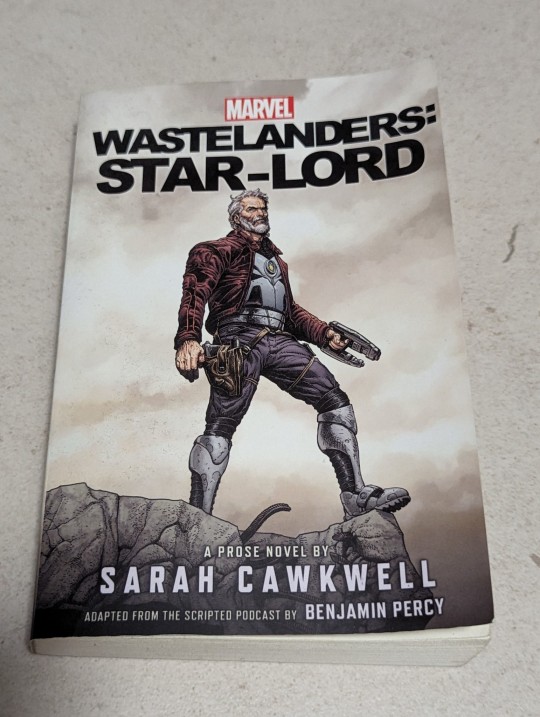

This one is a novelization of the audio drama 'Marvel Wastelanders', (which I recommend listening to if you haven't.) It's based on the Marvel Wastelanders comics but is an original take on the stories. Includes many comic book characters and comic references but can be read/listened to without prior knowledge of the comics.
It features an old man Star-Lord and Rocket Raccoon as they fight to save Earth from Doctor Doom's takeover. The story is told as a recount of events from a Rigellian Recorder whom they team up with along the way. Rocket and Star-Lord bicker like an old married couple and it's great. It's a good read, and has an interesting plot with a lot of fun characters. However it does have a tragic ending that the story never hid it was always leading up to. It's bittersweet. You might cry, but it's worth the tears.
The voice acting during these emotional scenes in the audio drama makes it worth listening to over reading but both options are good. Personally, I read the book first and then listened to the audio drama on Spotify. Sidenote, the characters in this are not voiced by their movie counterparts.
348 pages of the book, or 10 episodes around half an hour long each of the Star-Lord centric story of the audio drama.
Guardians of the Galaxy: No Guts, No Glory.
Written by M. K. England.

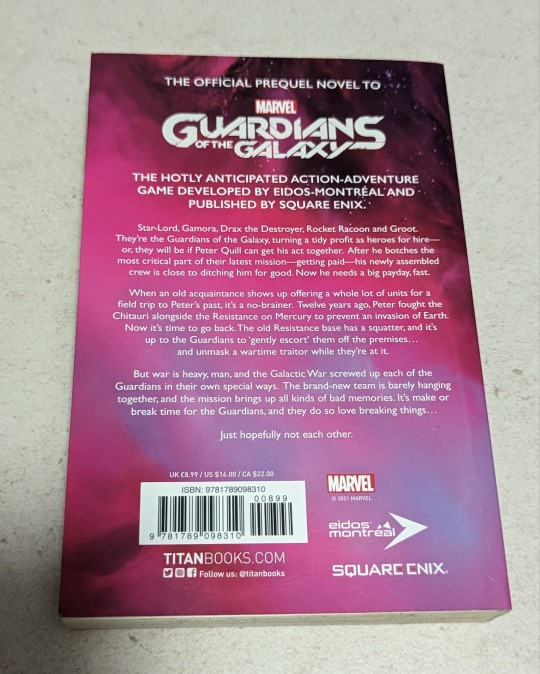
This is an official prequel to the Marvel Guardians of the Galaxy video game, (which is an incredible game that takes aspects from both the comics and movies.) Like the game, it's read from Peter Quill's perspective.
It switches between the 'present day' which is a time where the Guardians are only newly formed and struggling as a group, and 12 years before that during the Galactic War where Peter is a young ravager first meeting Nova officer Ko-Rel on Mercury as they battle a Chitauri invasion.
I really enjoyed this book. It's funny, heartwarming and action packed, and embodies the characters very well. I'd recommend it to any fans of the video game. It gives us a great preview of the relationship that Peter and Ko-Rel formed, and on the early dynamic of the Guardians.
If you haven't played the game yet, I highly recommend doing so and then going right ahead and giving this a read. Although in saying that, it'll still make sense if you read it without playing the game prior, it'll just make the experience more enjoyable if you have already played the game.
307 pages.
Guardians of the Galaxy: Collect Them All.
Written by Corinne Duyvis.


This novel is based on the comic versions of the Guardians.
The point of view jumps around between all members of the Guardians, so you get an insight on each of them throughout the story.
In this novel the Guardians embark on a quest to save Groot by collecting all the pieces that have splintered off him and scattered around the galaxy.
Gamora has her own significant arc in this story.
Another solid Guardians tale.
383 pages.
Guardians of the Galaxy: Rocket Raccoon and Groot Steal The Galaxy.
Written by Dan Abnett.
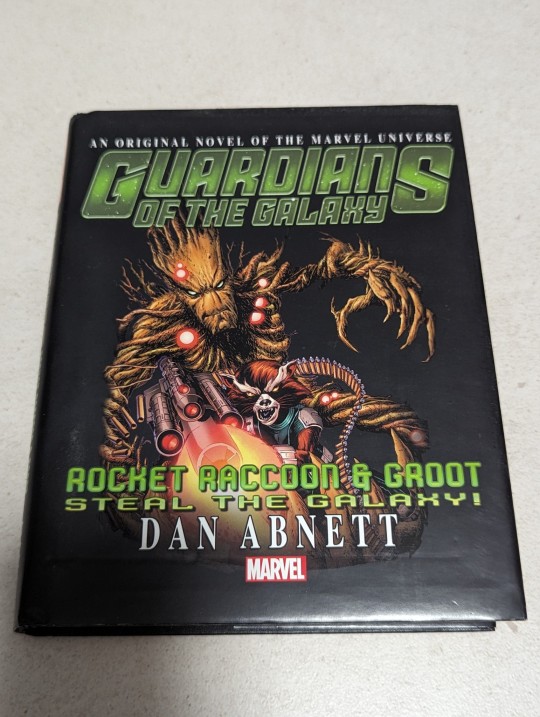
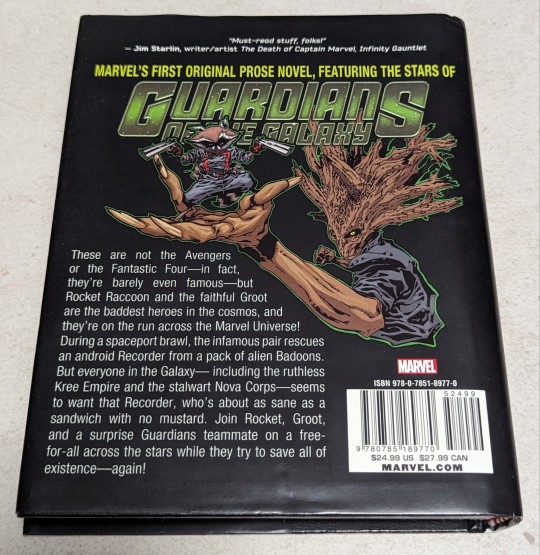
This novel is also based off of the Guardians of the Galaxy comic versions of the characters and was actually written by comic writer Dan Abnett who has written numerous Guardians of the Galaxy comics, along with many other notable comics.
In this novel, Rocket and Groot find themselves teaming up with a Rigellian Recorder on a quest to save the Galaxy. Gamora also pops in for a bit.
The book is read from the point of view of 'Recorder-Dude' as Rocket calls him, with a few interludes read from the pov of other characters.
This book was quite enjoyable. Would read again.
359 pages.
Apologies that the last two weren't as detailed as the other reviews, it's been a while since I've read them. Will have to give them a re-read and edit.
#marvel books#marvel#marvel comics#guardians of the galaxy#guardians of the galaxy comics#gotg#guardians of the galaxy game#rocket raccoon#peter quill#star lord#rocket#groot#gamora#drax#thor#yondu#books#novels#guardians of the galaxy books#book#gotg book#gotg books#mantis#gotg mantis#book review#bookworm#this sat in my drafts for so long
79 notes
·
View notes
Text
Captain Marvel #3 Review
Captain Marvel #3 Review #captainmarvel #caroldanvers #MARVEL #marvelcomics #comics #comicbooks #news #mcu #art #info #NCBD #comicbooknews #previews #reviews #Amazon
Writer: Alyssa Wong Art: Ruairi Coleman and Jan Bazaldua Colors: Bryan Valenza Letters: VC’s Ariana Maher Publisher: Marvel Comics Price: $3.99 Release Date: December 27th, 2023 Much like Rick Jones and Mar-Vell in the 70’s Marvel universe, small-time thief Yuna Yang and Captain Marvel trade places, one of them going into the Negative Zone whenever Yuna clangs her Nega-Bands together. Carol…

View On WordPress
#Captain Marvel#Captain Marvel 3#Captain Marvel 3 Review#Clea#doctor strange#Marvel#Marvel Comics#marvel comics review#marvel comics reviews#negative zone#review#Reviews
5 notes
·
View notes
Text
Uncanny X-Men #8 review - Raid on Graymalkin finale
Raid on Graymalkin has been a strange event in a lot of ways. It happened very early after an editorial and creative team change, it's only four issues spread over 2 books, and perhaps most of all, editorial both spoiled the ending and hyped up an ideological divide between Rogue and Cyclops. The big question is 'was the hype paid off?' Sadly, no - Uncanny #8 doesn't so much land the plane as crash it into a mountain. A plane crash can be a spectacle though, let's break it down. At the very least it looks great. This is a long one, so strap in.
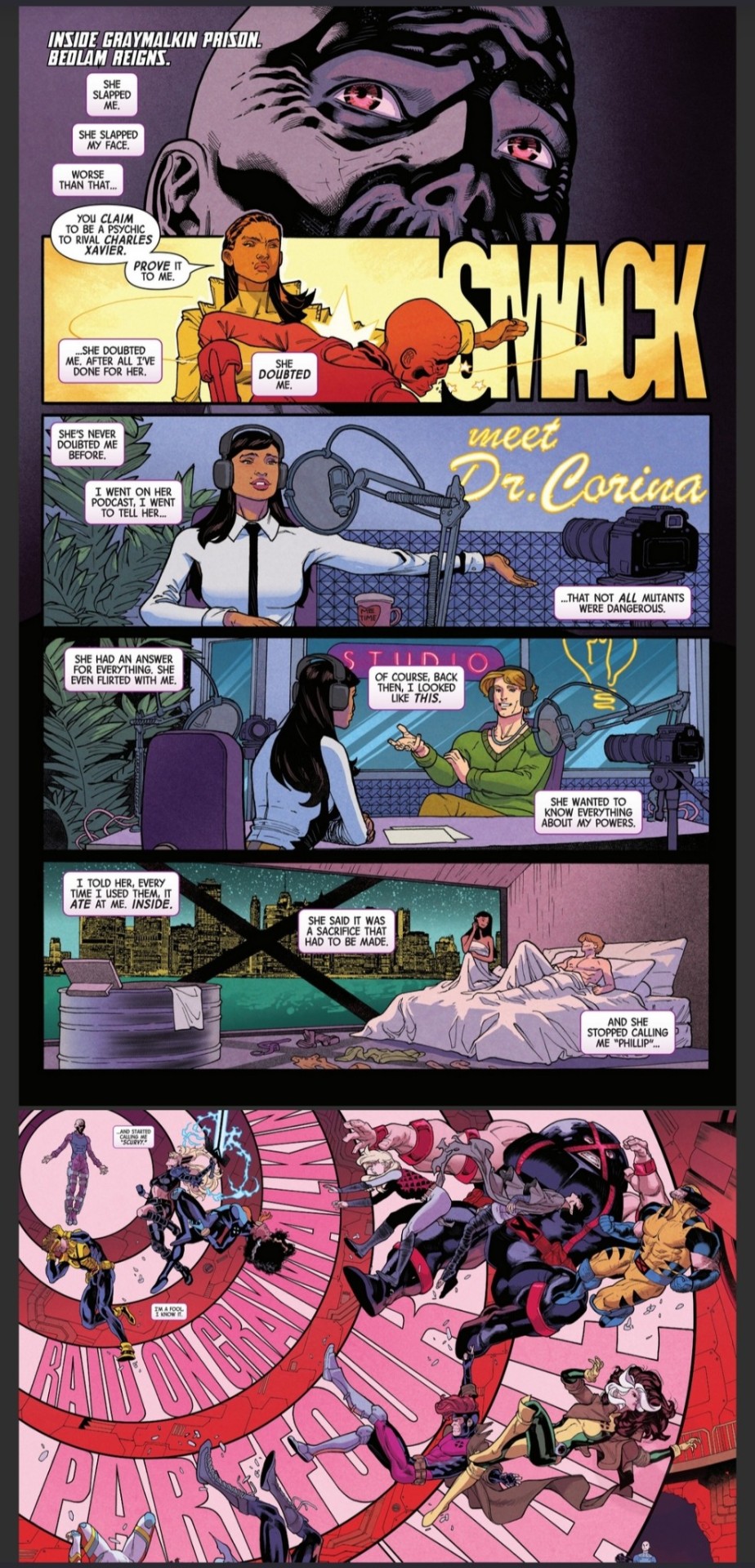
We get to know Scurvy a little better.
X-Men #9 ended with both teams in Scurvy/ Philip's psychic thrall and Charles Xavier taking the stage after Kurt and Kwannon freed him. Uncanny #8 opens with his POV of his recent history, showing a 'Not All Mutants' mutant and how he ended up in an abusive relationship with a right wing podcast host. Well, it shows how they met, how his powers work, and how Warden Ellis has used him.
His powers aging him drastically explains why he's reluctant to go all out and perhaps how his powers helped an Infowars knock off to get this job. YMMV on whether this makes him sympathetic; it's certainly a 180 from the plain pathetic he has been portrayed as thus far. We spend a lot of time with him this issue, but it's all so vague I don't feel like we actually know all that much about him. He is portrayed as a victim, though he's also in the process of frying our heroes' brains and enslaving people. On the other hand, we get so little of his motivations and feelings that there's not much there. Villains/antagonists need to be developed to be interesting, and I'm not sure if Scurvy is a victim of Ellis' crusade or a self hating mutant who gave 'everything to a dream' for ... reasons. He's literally killing himself and it'd be good to know why.
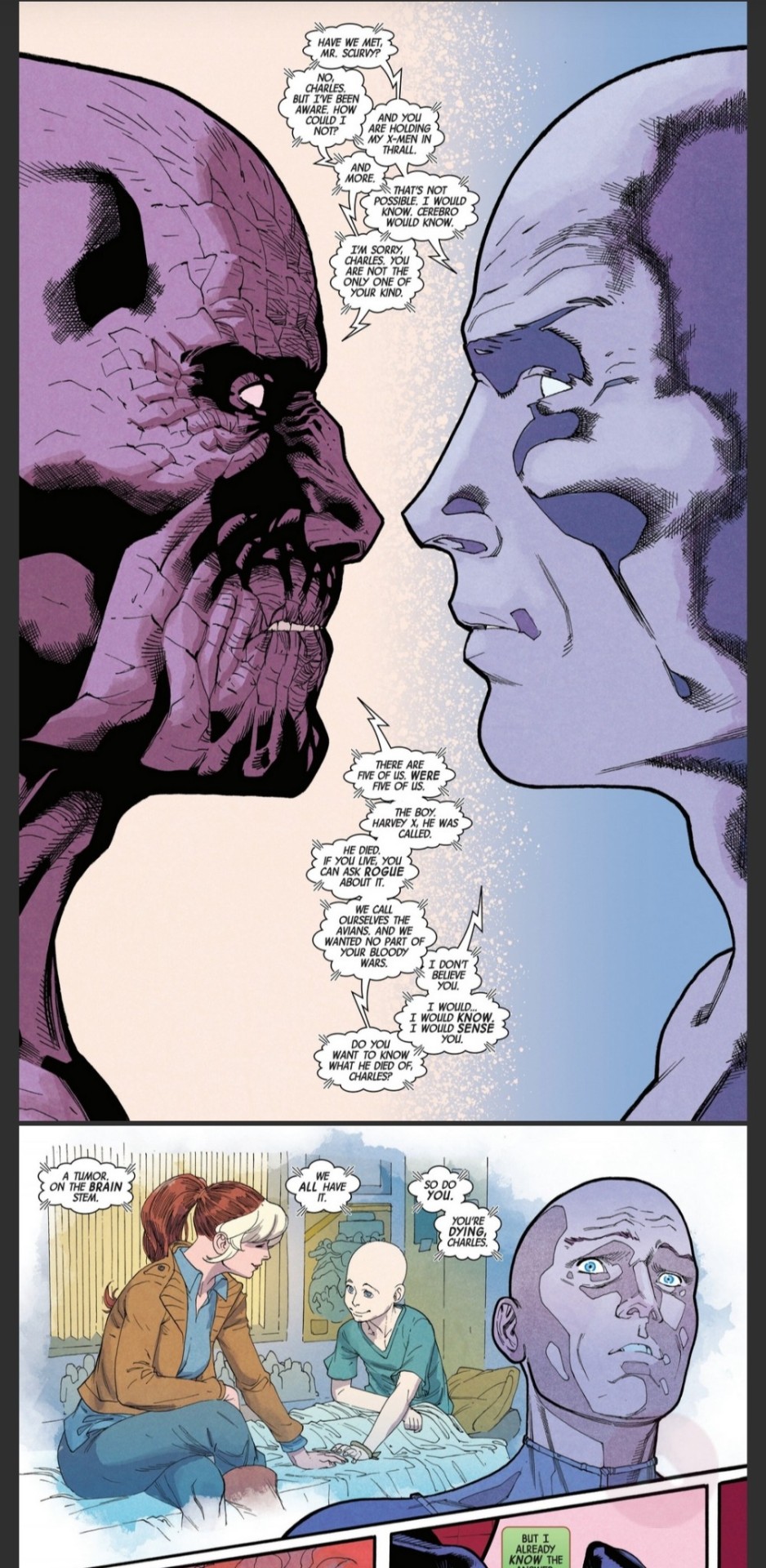
Scurvy has been hyped as a Psychic on par with Xavier, something Xavier himself hasn't exactly confirmed but he has admitted Scurvy is an obstacle. They haven't met but Scurvy's been aware of Xavier, presumably because he's world famous and announced Krakoa to everyone on the planet. Scurvy suggests it's more than that - he and Charles are part of a group of five mutants called Avians, one of whom died - Harvey X. Chuck has had an oversized presence in Simone's Uncanny X-Men and another vague mystery about him takes up space that could be used to develop other characters - The Outliers, Jubilee, Nightcrawler. This 'Avian' business feels like The Twelve and other similar half baked plots, and how can Charles have a tumour if he's in a relatively new body? He died last in Inferno AFAIK, but more than that it feels unnecessary. I'm not invested in believing or disbelieving it, though Chuck dying might make X-Manhunt more interesting.
Chuck isn't showing up again until March, and Scurvy ages 10 years during this issue. Why are we spending all this time on these people that aren't main characters? Does Xavier really need to be part of some special unexplained group? He's been a very special and prominent part of the X-Men since 1963 - new old girlfriends and vague hints of specialness feel like mystery box overkill. Maybe Scurvy is lying as part of their psychic battle. Laws of narrative economy suggest otherwise, but either way - what's the point? Also, Avians? Are they birds? Maybe it's a Shi'Ar thing but right now it sounds ridiculous. Avians 🙄
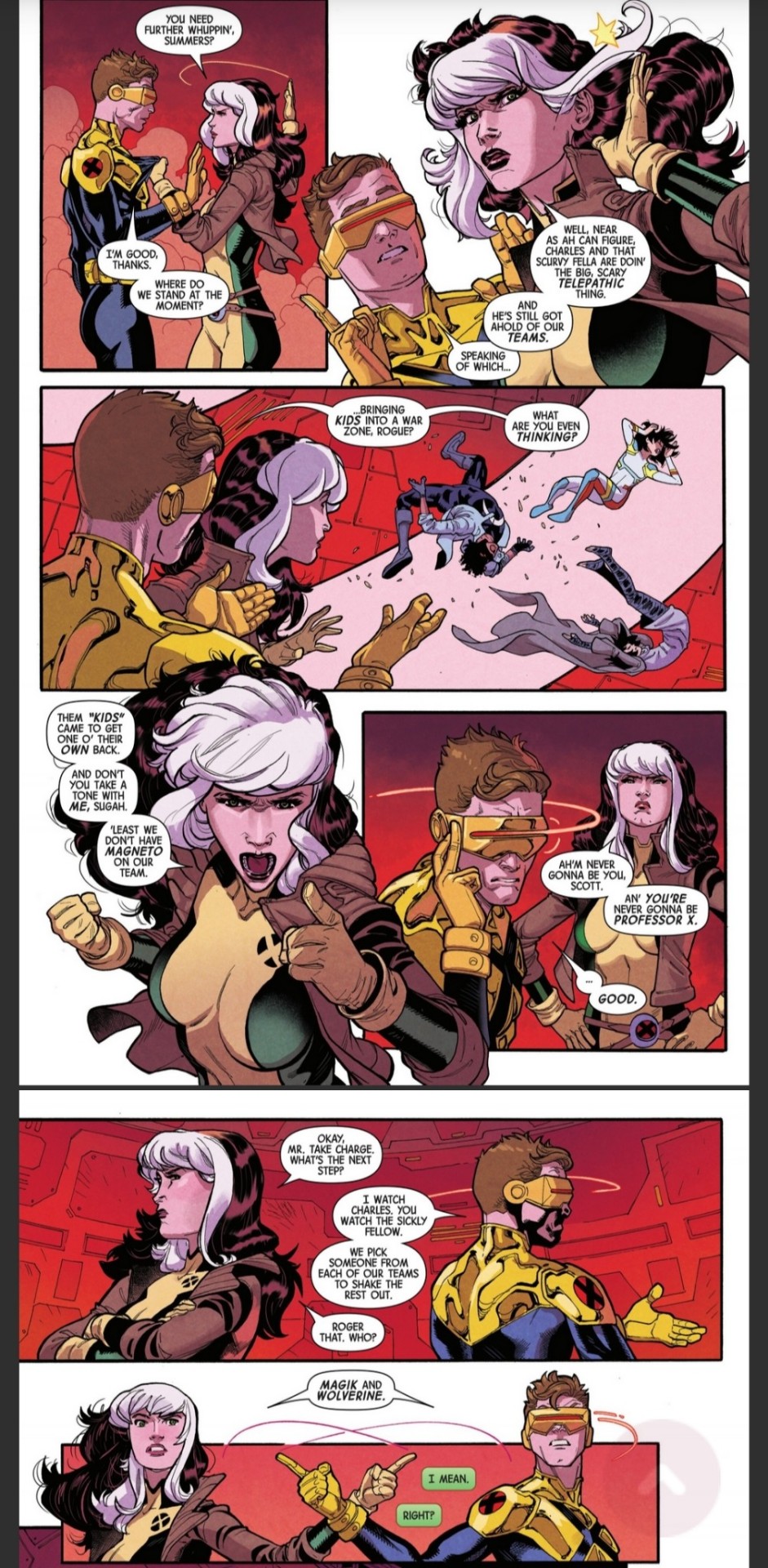
Juggernaut knocks Rogue out of Scurvy's control and she thinks she has time to do the same to one other person. She apologises to Gambit for not choosing him and picks Cyke as the tactical choice, nearly knocking his head off. He snaps out of it too and shit gets bizarre.
For some reason Scott chooses this moment to berate Rogue for 'bringing kids into a war zone' which is a super valid point but I find it difficult to believe he'd bring it up while they're on the back foot and threats are everywhere. Rogue's answer is even more puzzling. I can believe she'd make an appeal to emotion but it's not a real answer. 'At least we don't have Magneto on our team' is not a rebuttal to nearly getting children killed, but it also does not make sense.
Magneto has been reformed for YEARS at this point and was a driving force behind Krakoa. She's saying like he's some irredeemable villain when he's the most heroic he's ever been. He and Rogue had zero interaction on Krakoa, where he was considered a national hero and famously was very tight with her hero Xavier. If she has an issue with the sins that came to light after Inferno, then she wouldn't be so charitable to Chuck, either. Maybe it's Scurvy's influence, but if so then what's the point? This isn't ideology, it's dodging the question at worst or petty bickering at best. Has Rogue forgotten her extensive history with Magneto, or her own start as a villain? What about her husband's involvement in the Mutant Massacre or her parents' unrepentant villainy? When considered in the context of Simone saying that Rogue and Cyclops would occupy the Xavier/Magneto relationship it looks like a missed shot. You'd have to ignore decades of history to make it work. Sigh, this was an unforced error and it really bums me out.
'I'm never going to be you and you're never going to be Professor X' is flat out weird. Cyclops answer of 'good' is consistent with his argument last issue, but it makes it look like they're not having the same conversation. Finally they realise they're in a war zone and only now does Rogue defer to Cyclops. Oookayyy. They say 'Magik and Wolverine' together in a moment that's both cheesy as hell and should underline their commonalities. I'm almost feel bad ragging on this, but it's not executed well. At least Rogue is consistently characterised as a cowboy. That's something.
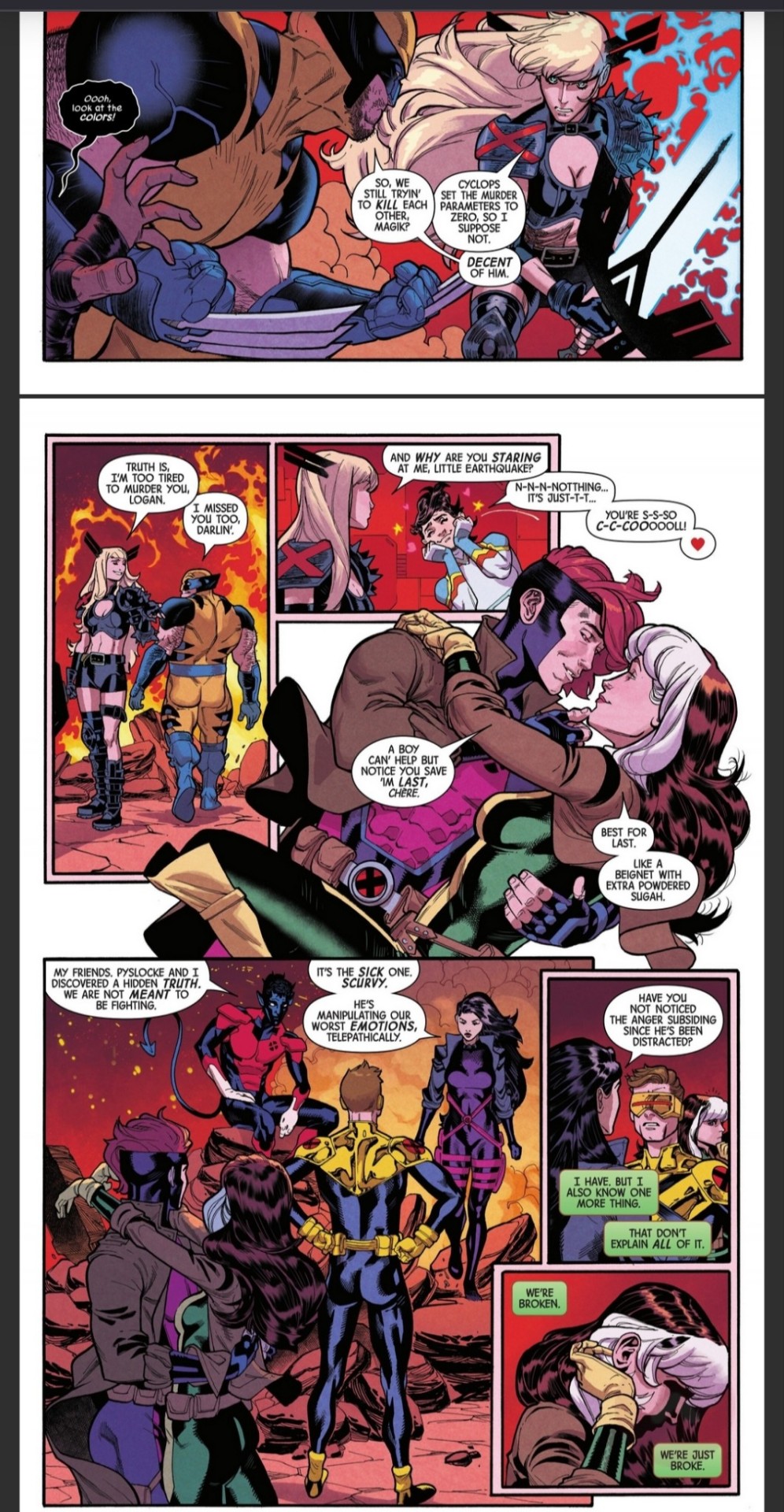
Magik and Wolverine start freeing people then stop to agree not to kill each other. Deathdream says weird stuff, as usual, and the two make up. Jitter has her second instance of love heart emoji'ing a woman, which is cute but still deniable as actual WLW representation. I hope Simone cashes this cheque.
Queerness should be something that's not notable in a perfect world, just a part of the character. We don't live in a perfect world though, and we don't know a lot about Jitter. We know her powers, that she's Malay Singaporean, that she has a stutter, and that she possibly likes women. It's not enough for issue #8 of the flagship series. The choice was made to heavily focus on Xavier and Sarah Gaunt, and a casualty of that was getting to know main characters. It wouldn't be such a big deal if the payoff was worth it, but what did we actually learn? Instead of giving readers a break from Charles Xavier, he's been a regular presence. His appearance in this event could have been more impactful but I feel like we never had a chance to miss him.
Kwannon and Kurt reveal that Scurvy made them fight, which Rogue is aware of, and she adds that 'we're broken.' I'm not sure what that's supposed to mean, but this undermines the stakes of the ideological conflict. Is it manufactured or isn't it? None of them consider attacking Scurvy while he's fighting Xavier, either. Nobody is acting like they're in danger. It feels unserious, like the characters are just waiting for things to happen to them.

At this point I don't really care who Inmate X is. Uncanny X-Men has been dropping these mystery boxes that readers can only guess at, and like with Harvey X being the one pulling strings, it comes out of nowhere. It's another Avian, which means nothing to us beyond a vague implication of specialness. We know that Ellis considers it a bad thing if he get out of his cell, but that doesn't narrow it down aside from it being a he.
Aw, cripes - popular gen Z saying
Interestingly, Xavier's astral form is that of his Cerebro-helmeted onesie twink. It could reveal that he hasn't changed at all in how he sees himself and his role as shepherd of mutantkind. It's very different from his classic astral battle appearance, and I love it thematically and visually. Scurvy and Chuck as astral giants towering over the schoolprison is striking, though the casualness of their dialogue mutes it somewhat.
Not sure how Ezra or Ellis can tell Scurvy is losing a battle on the astral plane, but she does what she should have done before this and gets a gun. Calico is overjoyed that the Outliers (except Jitter) came for her, but what could be a heartwarming moment is undercut by their dulled expressions. I can buy Deathdream doing this, but Ransom has been emotionally aware prior to this. We have zero details, but aren't these kids tight after months of being on the run together?

It's finally time to stop standing around, as Ellis and guards are here with guns. The X-Men, having already beat up plenty of these dudes, aren't impressed. They stand together (no idea where Chuck and Scurvy got to) and Cyke urges her to stand down, pointing out that they're not as nice as the Avengers. Rogue agrees in the shittiest way possible, thinking 'sometimes visor boy says jus the right thing.' Weird ableist stance from Rogue, but all it does is highlight how shallow their conflict is and remind us that Gail Simone doesn't like Cyclops.
Ellis doesn't blink, telling them her 'brother died because of trash like you.' We knew this already, and I'm wondering if there's anything else to her. She's established as a threat but she's not especially interesting. She helped with Sarah Gaunt out of empathy (?) but here she is flinging the same old slurs. I'm not sure if her dark skin is meant to be noteworthy or say anything. So far it hasn't been a part of her character in any way other than visual, no commentary on how someone who has experienced minority oppression becomes so hell-bent on dealing it out herself. How does a person become willing to enslave and torture, and even (as we'll see) destroy two towns with thousands of humans in them? Her brother died, sure, but that's thin characterisation for a multi-arc villain.
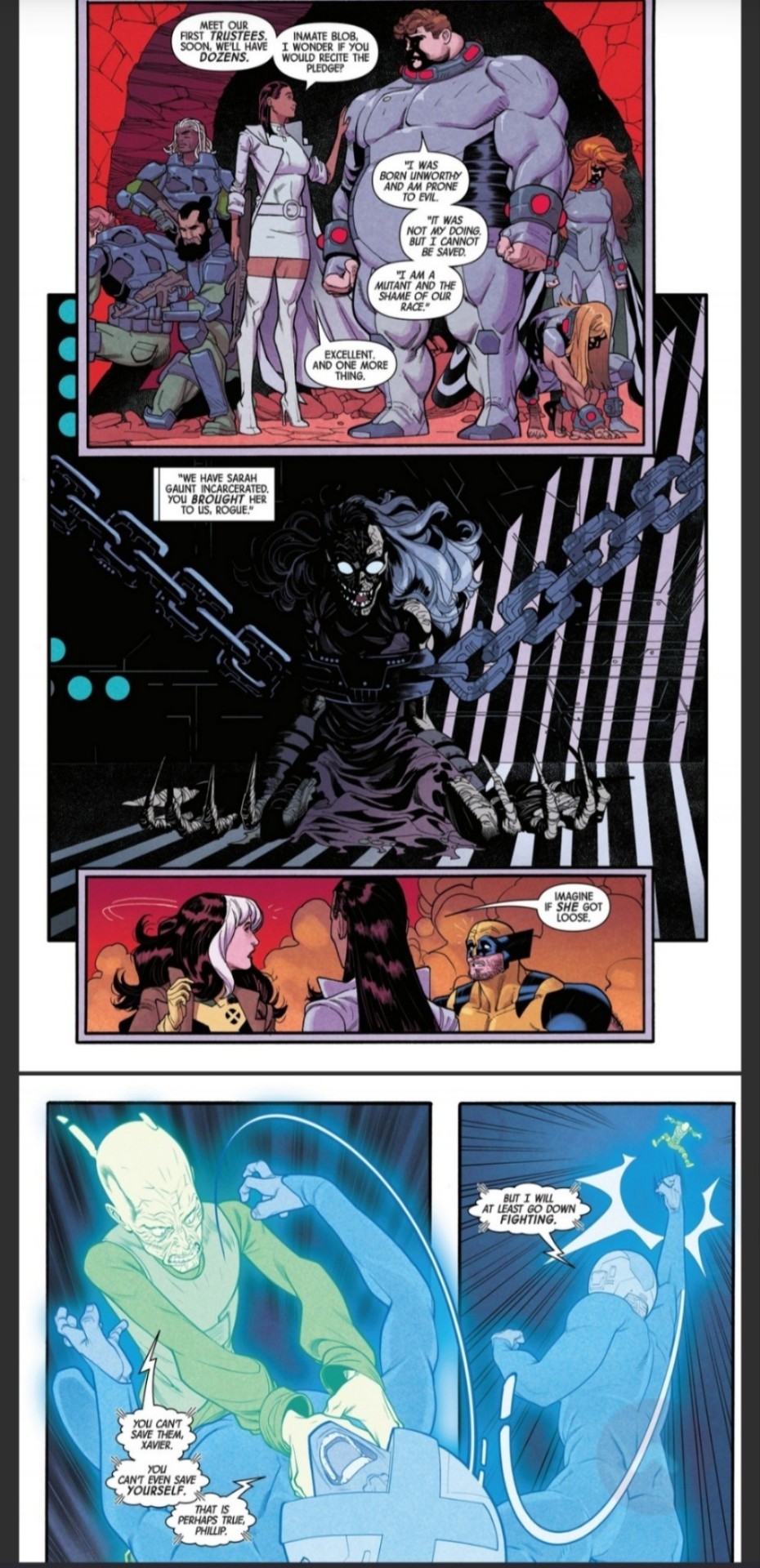
Chuck wallops Scurvy with an uppercut!
Ellis brings out The Trustees again (who the X-Men easily defeated) to have Blob recite 'the pledge.' Very messed up but it shouldn't exactly convince the X-Men to do anything other than smash this place to pieces. She threatens to let Sarah Gaunt loose from her comically large chains that shouldn't stop her for a second.
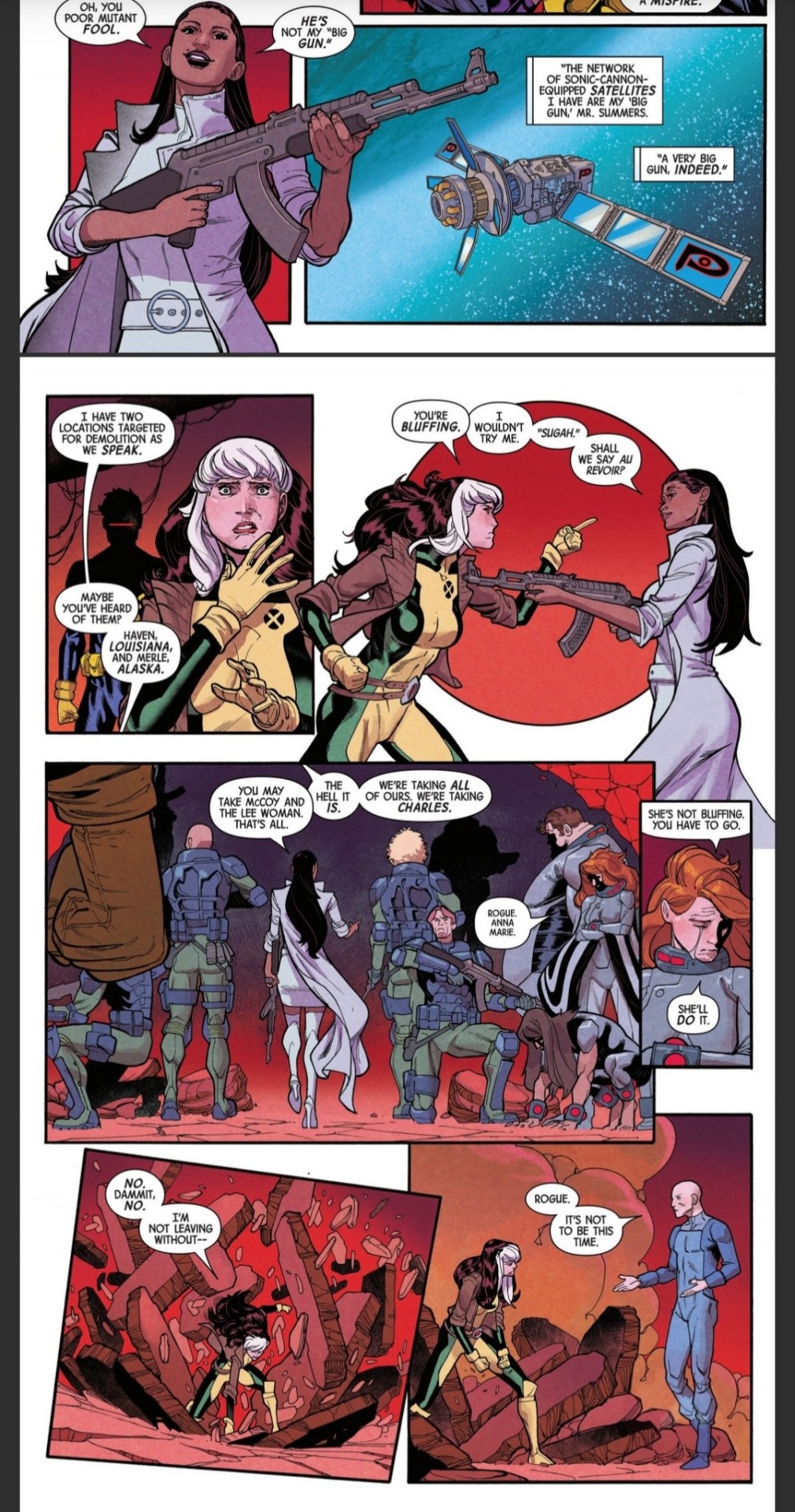
Cyclops points out that with Scurvy's defeat Ellis' big gun is down. She laughs at that, and for some reason Chuck doesn't immediately take over her brain. Her big gun is more literal - a fucking network of sonic cannon satellites. Who TF gave this lady a Death Star? She has Merle and Haven targeted but Rogue thinks she's bluffing. Logically, you'd think so. Would the US government really accept this maniac destroying towns with a space laser? Not sure how they'd spin that. Also, neither team have any leverage to stop her using it whenever she wants. I feel like she's forcing them to kill her right here and now, lest their strategic position becomes 'able to be killed at any time without effort.' They could even just send her on permanent vacation to Limbo, see how her bullshit flies with Maddie Pryor.
Ellis lets them take the people they came for (why?) but that's not enough for Rogue. Siryn speaks to Rogue personally while crying, indicating she's herself, as much as she can be with all the torture, mind control, and who knows what else? It's only when Xavier intercedes that Rogue listens.
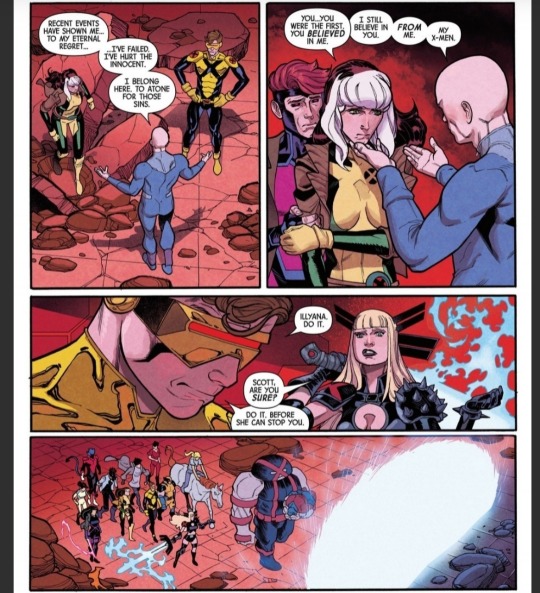
Charles explains why he needs to be in prison (though we know he'll change his mind and escape in March) and they have an emotional exchange. It works, I guess, but Rogue looks super selfish and ignorant. Free Charles for personal reasons when he doesn't want it at the cost of two towns? Doesn't seem like much of a choice (other than knocking Ellis out while she's in your face.) It feels a bit regressive for Rogue, too. She is aware of everything from Fall of X (including Chuck manipulating one of her mothers and trying to permanently kill the other) and hadn't really had or needed a mentor in a long time. Sure, everyone is lost after Krakoa, but WTF is she so attached to Xavier? It's great that he was the first to believe in her but this feels almost infantilising. Rogue is better than this.
Scott has Magik open a big portal before 'she' can stop you. I assume 'she' refers to Rogue, except Rogue is shown willingly walking through it with everyone else. Ellis wasn't interested in stopping them. It's like everyone has the script and realises the event is over so it's time to go. I have difficulty believing any of these characters would just meekly leave, not because of Xavier, but the multiple sonic space cannons that can kill them anytime plus their enslaved comrades. There's eight regular ass humans with guns in the way and this is their shot to do anything about it. How many of these X-Men could take them all out by themselves? Cyke could optic blast them unconscious, Magik has multiple methods, and many of the others could just punch them while ignoring bullets.

Yo, where's Quentin? He arrived with you guys.
Once Rogue has walked through the portal (clearly willingly and without duress) she objects again - 'no. We can't leave him there!' Cyke echoes Charles' own words and promises to get the others out, but Rogue punches him maybe ten feet and not only repudiates Scott's promises (?) but places the blame entirely on him. He blasts her and tells her to grow up (kinda fair) but then their teammates hold them back. Beast tells Scott he won, but this looks like a narrative trick to pretend Cyclops wanted to fight or has any reason to.
Rogue turns to leave with mild venom and her team follows. Hank assures Scott that he had no choice and Scott disagrees but doesn't elaborate. I hate to see X-Men fight but it's even worse when it's over nothing. The post-portal events feel like Simone going 'hmm, didn't really sell that ideological divide or their falling out, fuck it, just have Rogue punch Cyclops.' I think Cyclops was mostly right here, but it's more than Rogue was wrong and the conflict was contrived. I just don't buy the degree of animosity Rogue has and all the reasons given feel out of character. If that's who Rogue is right now I can accept it, but it's not very heroic and she's had multiple egregious failures of leadership. If this is identified as a character flaw that needs working on or a mistake that she regrets it could make for interesting storytelling, but all the information we have suggests that's not the case. Uncanny is frankly a trainwreck, but at least it looks fantastic. The letters page and other media suggests a lot of people are enjoying this book, and I couldn't be happier for them. I just wish I was too. I'll keep reviewing it of course, and I'll be less harsh than this review was. It was hyped and it called shots and didn't deliver. Doing that sets expectations and gives me another metric to judge it by. Hopefully we can get on with learning about the characters who've been neglected.
As for Raid on Graymalkin as an event, it had its ups and downs. Most of the ups were in X-Men and most of the downs were in Uncanny. Ultimately it didn't fulfill the promise it made so I judge it as a failure. We didn't learn a great deal and it boiled down to a cynical excuse for X-Men to punch each other. The mysteries it introduced feel dull to me and I am not especially interested in the Avians or Inmate X. The solicits for X-Manhunt spoiled that Xavier wasn't going anywhere, which left us with forced conflict. I'm far more interested in the aftermath of the event, especially the Alaska team dealing with a visit from the O*N*E. They don't really need much reason to fuck with the X-Men so I'm not crediting the event with that.
Thanks for reading!
#raid on graymalkin#uncanny x men#x men#rogue#cyclops#charles xavier#professor x#magik#wolverine#corina ellis#x comics#marvel#comics#review#scurvy#gail simone
64 notes
·
View notes
Text


Doctor Doom holding his Latverian Express credit card by artist Mike Mignola (a fake ad from 1990's Marvel Year-In-Review Vol.1 #2).
#Doctor Doom#Mike Mignola#latverian express#dr doom#dr. doom#humor#comics#marvel comics#90s#art#1990s#comic books#latveria#super villain#victor von doom#ad#fake ad#1990's#90's#credit card#Marvel Year-in-Review#early 90s#magazine#zine#doom#king of latveria#it's good to be king#marvel
69 notes
·
View notes
Text
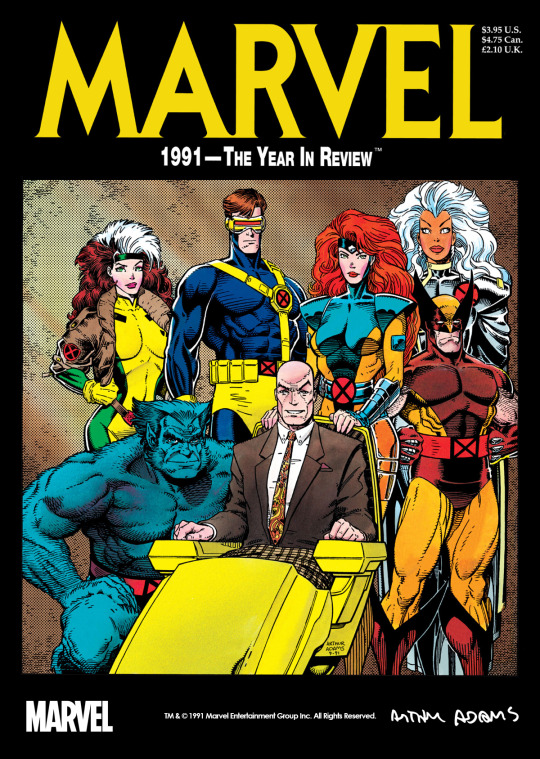
The X-Men by Art Adams with colors by Gregory Wright on the cover of Marvel 1991 - The Year In Review (1991)
#marvel comics#marvel magazines#x-men#uncanny x-men#art adams#gregory wright#marvel year in review#marvel 1990s#marvel 1991#marvel 1992
156 notes
·
View notes
Text
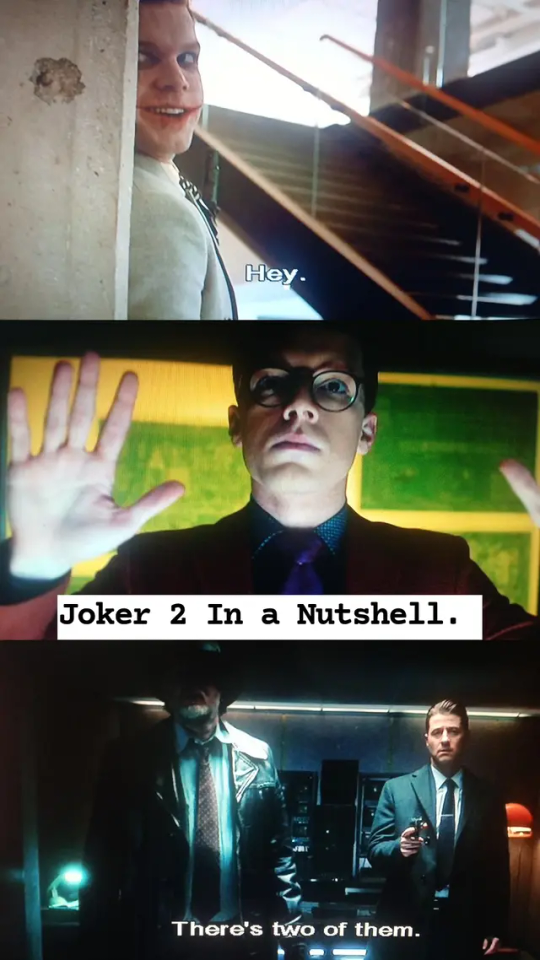
#batman#vintage#superman#smallville#dc#funny#lol#comedy#humor#haha#joker folie a deux#joker 2#comic books#trending#explorepage#2000s#nostalgia#bruce wayne#marvel#movie review#tvseries#gotham#cameron monaghan#shameless#deadpool 3#deadpool and wolverine#ryan reynolds#hugh jackman#the penguin#jerome valeska
72 notes
·
View notes